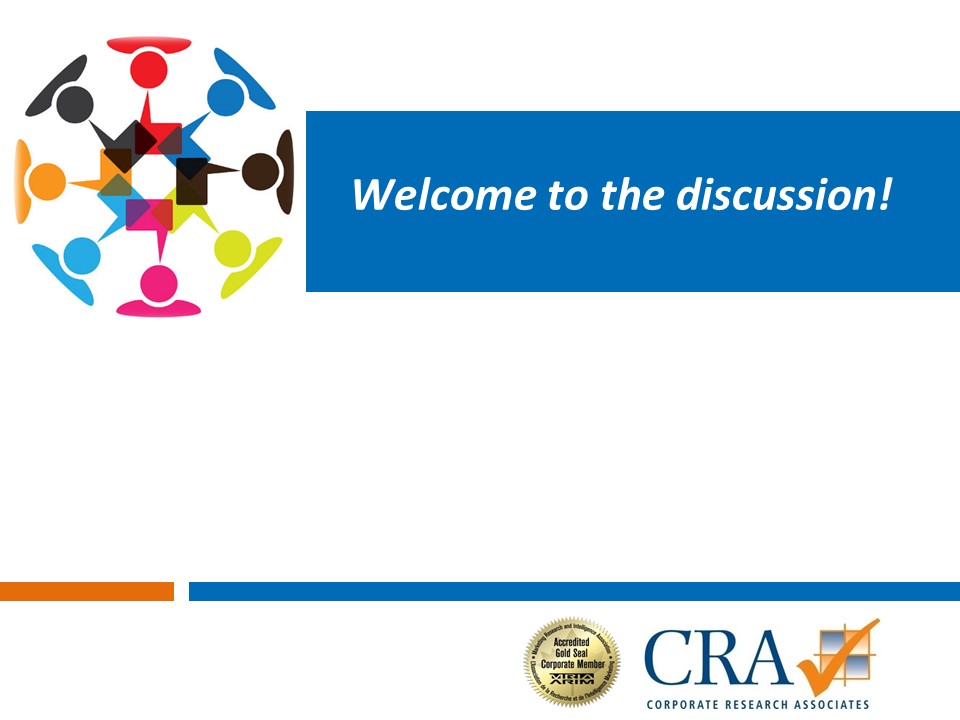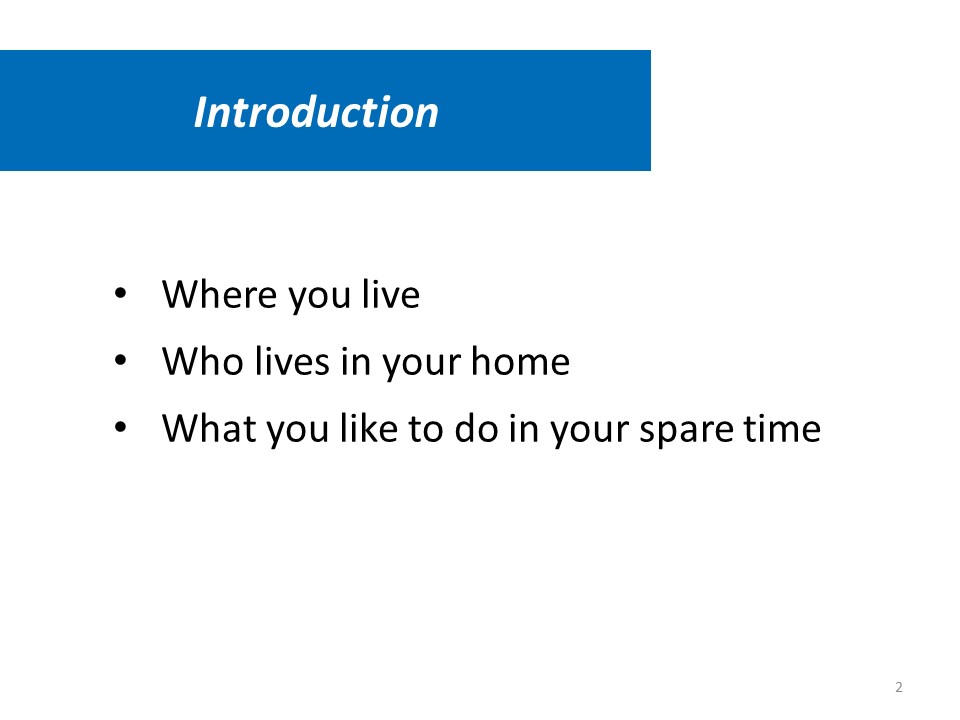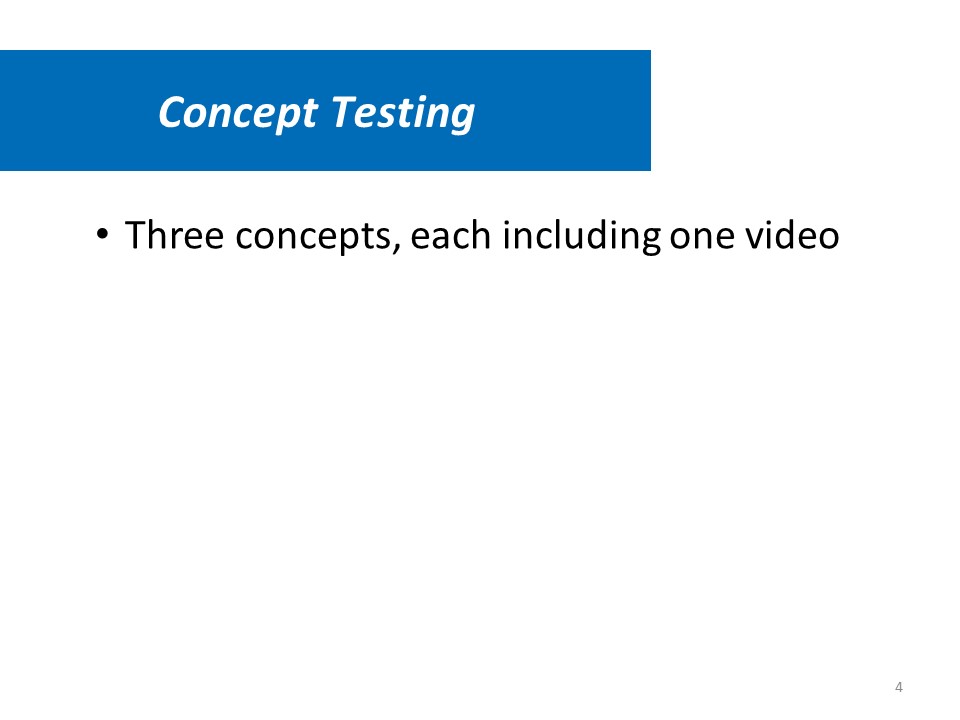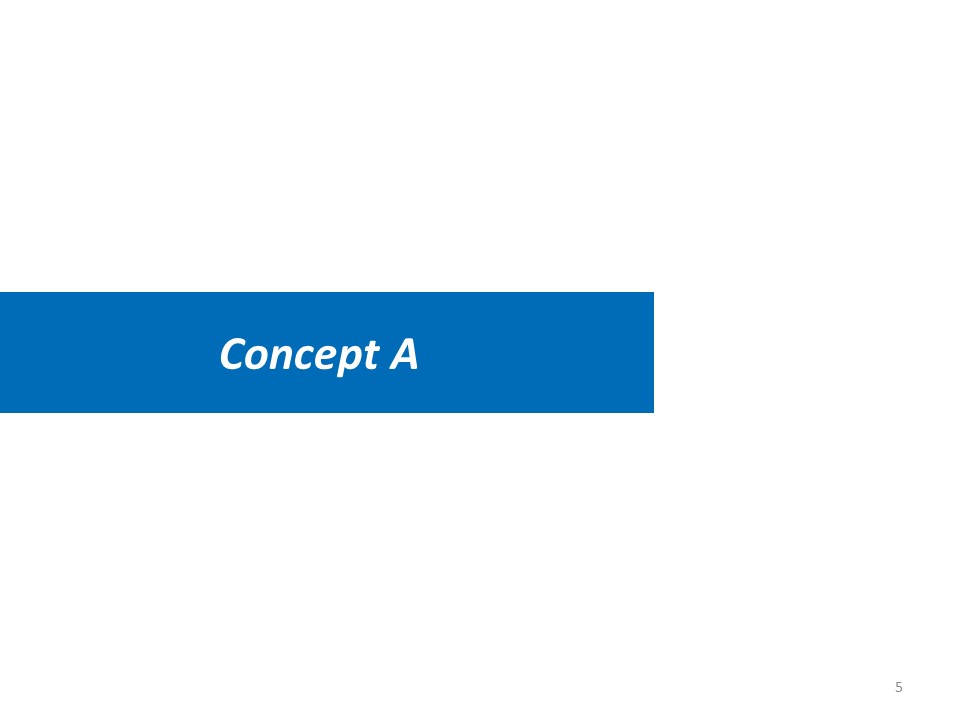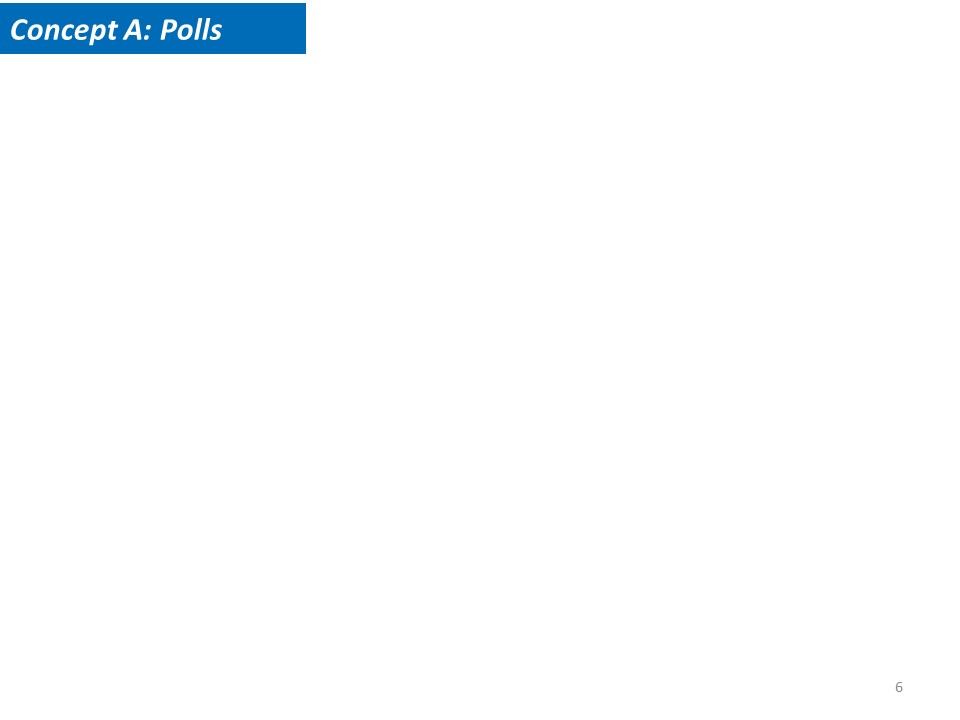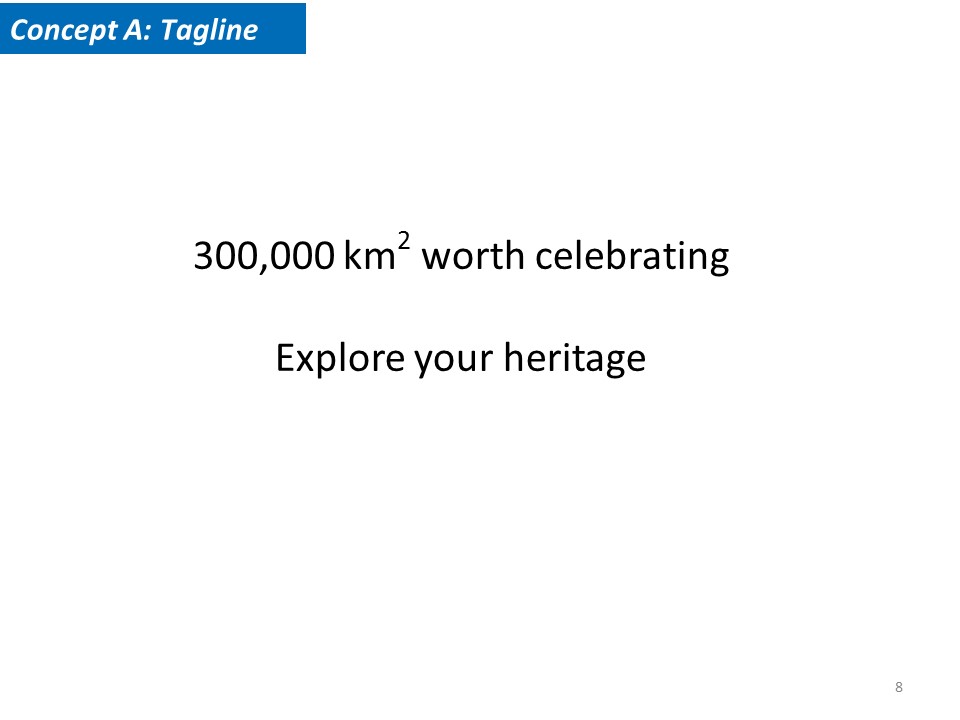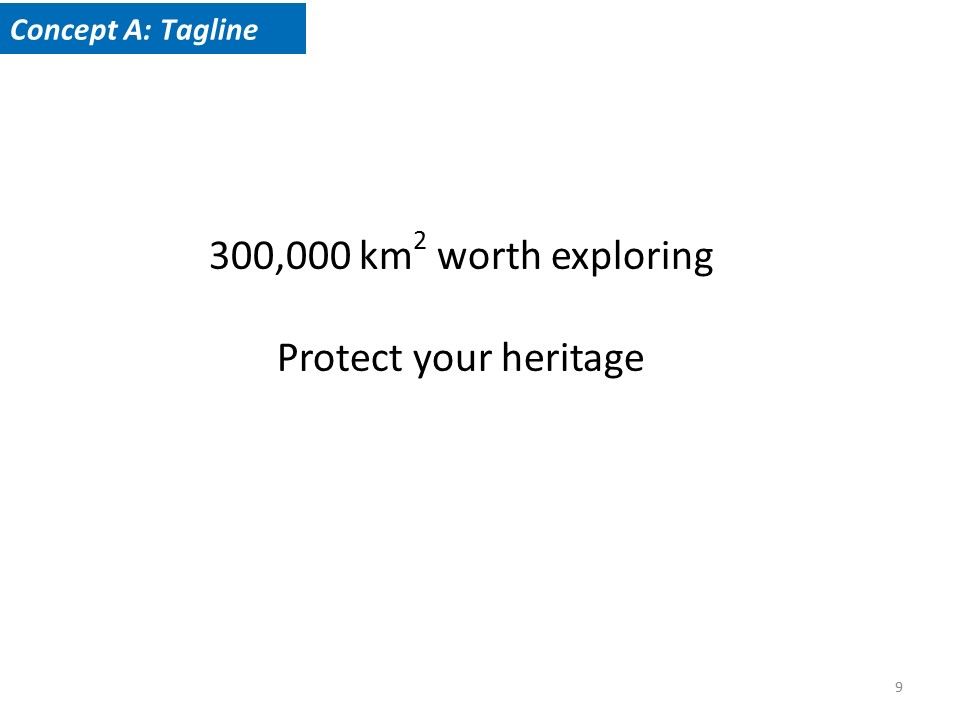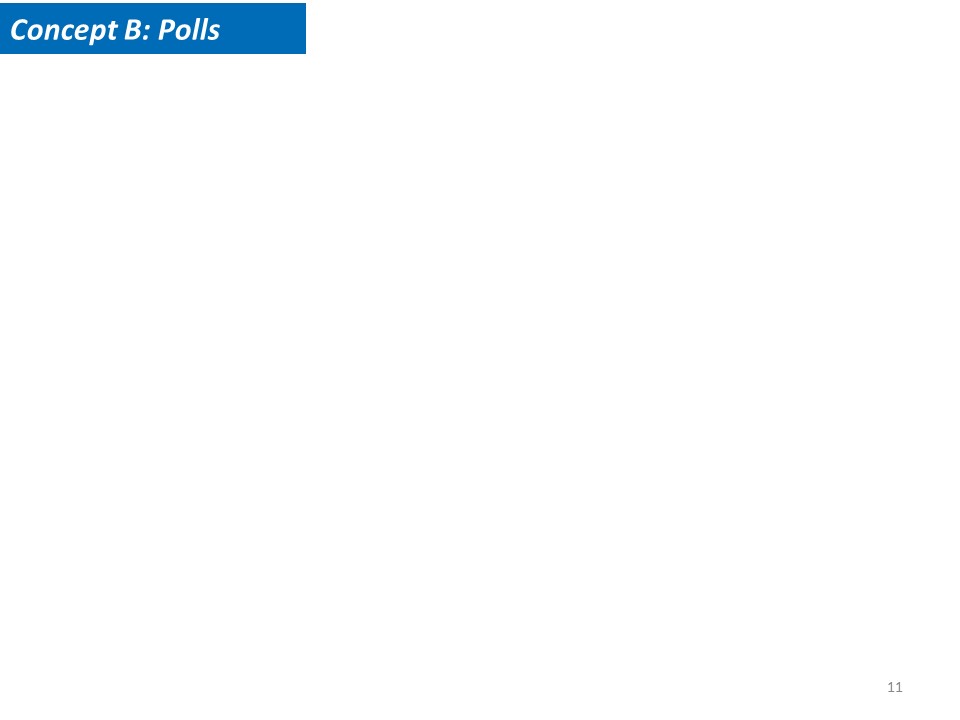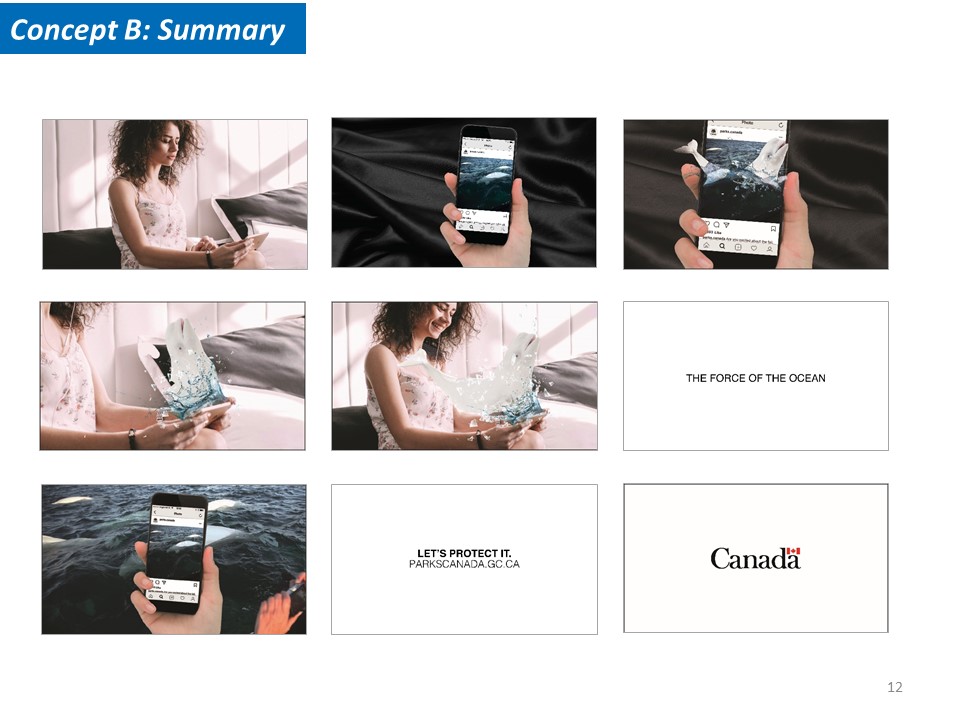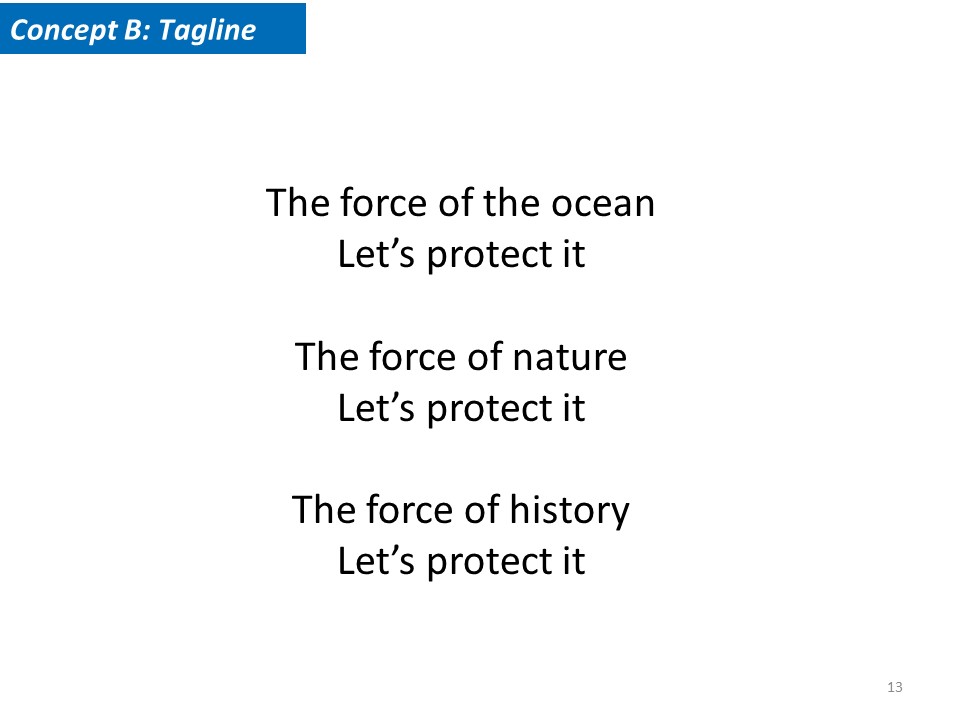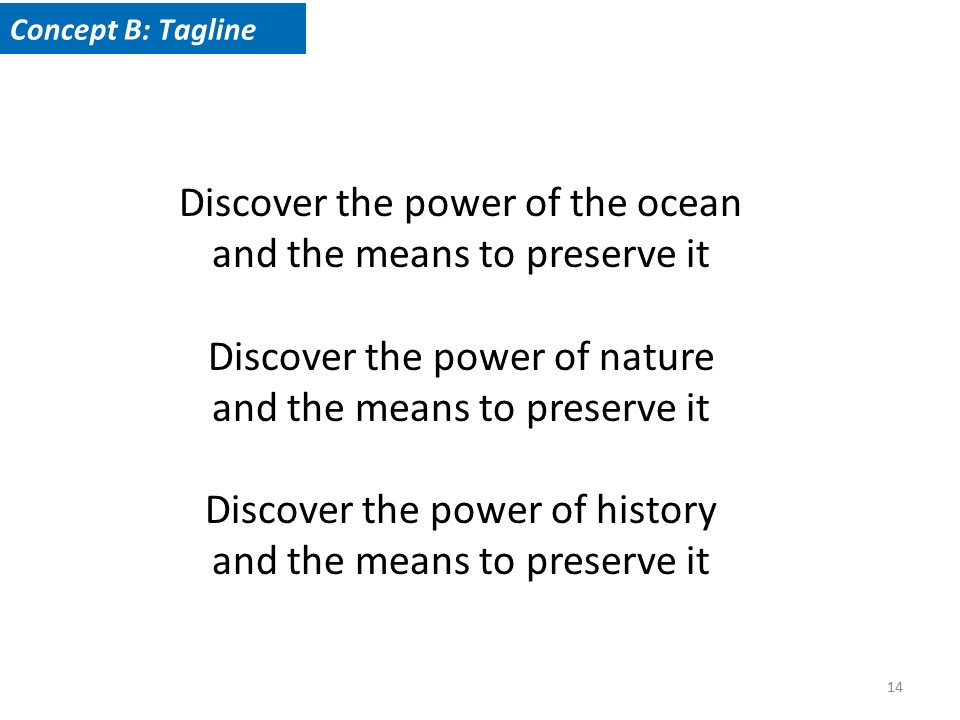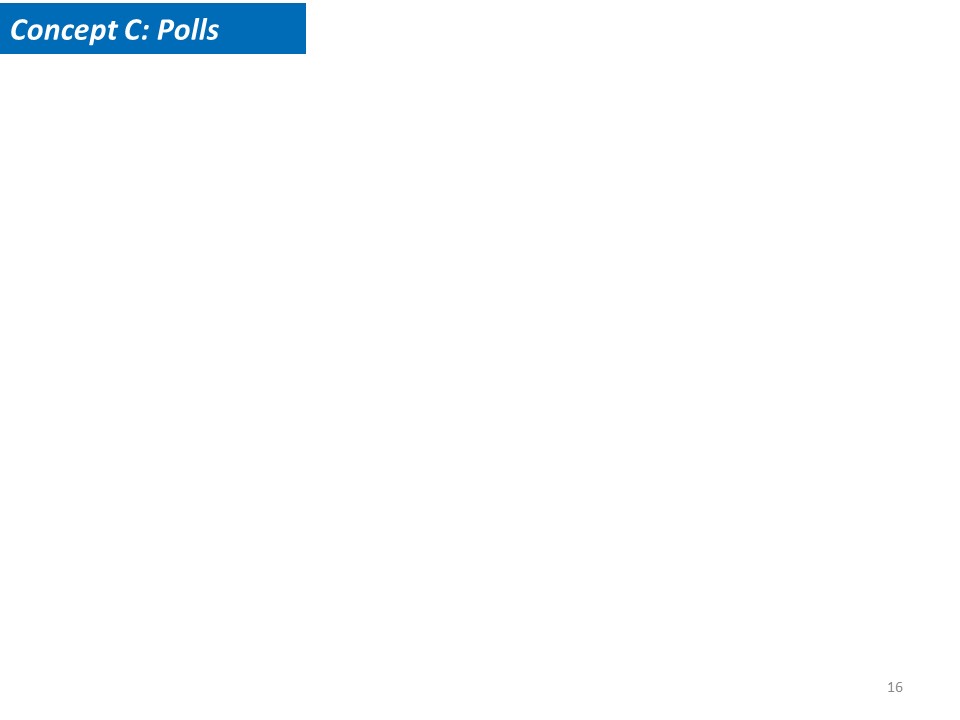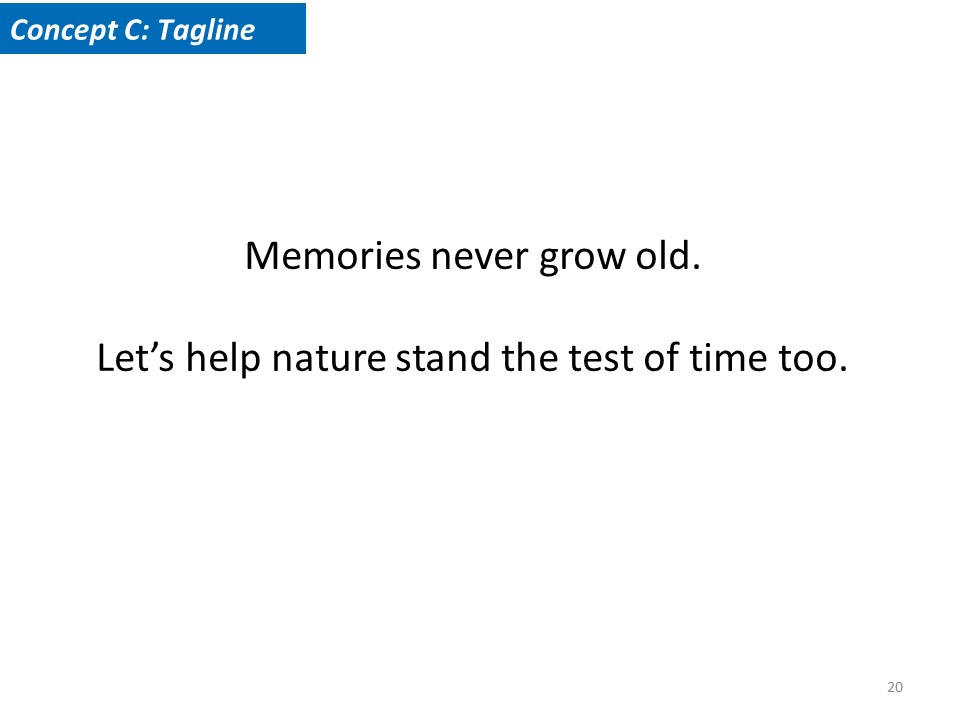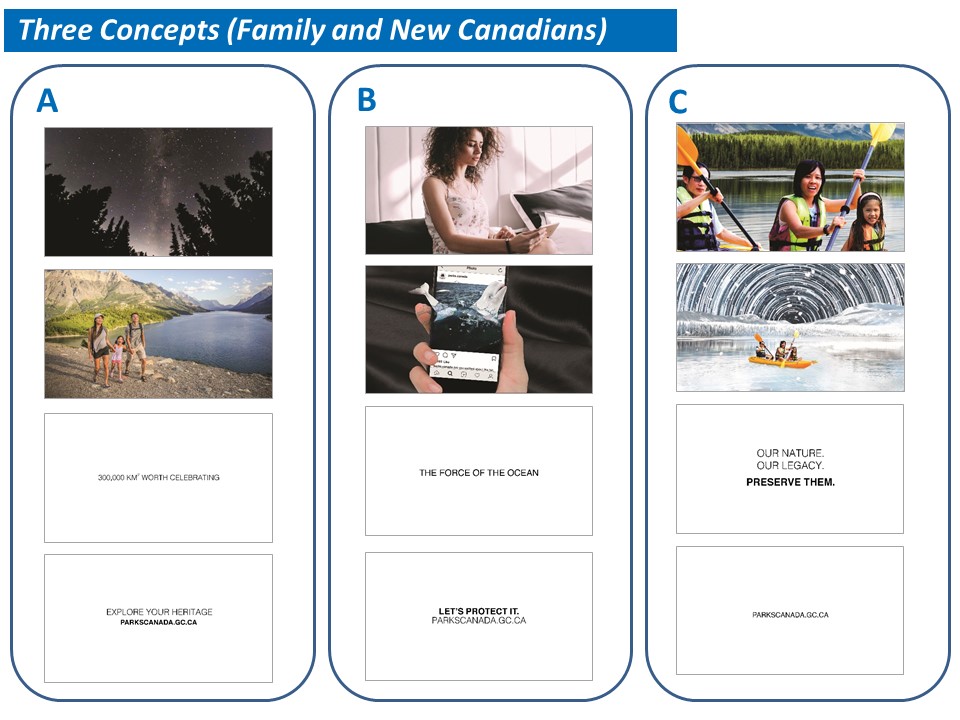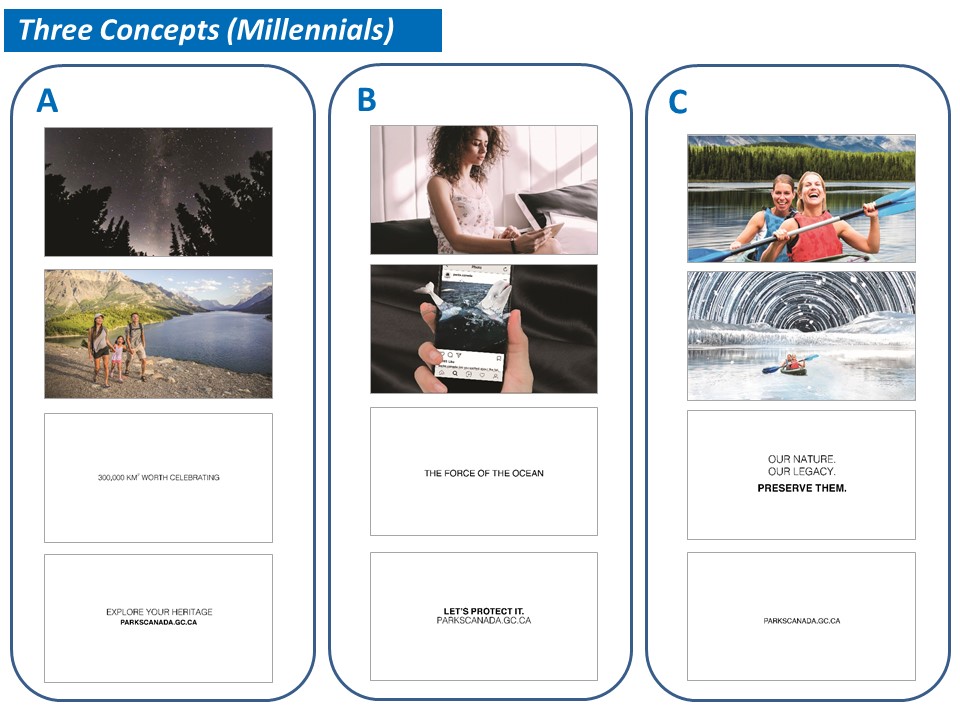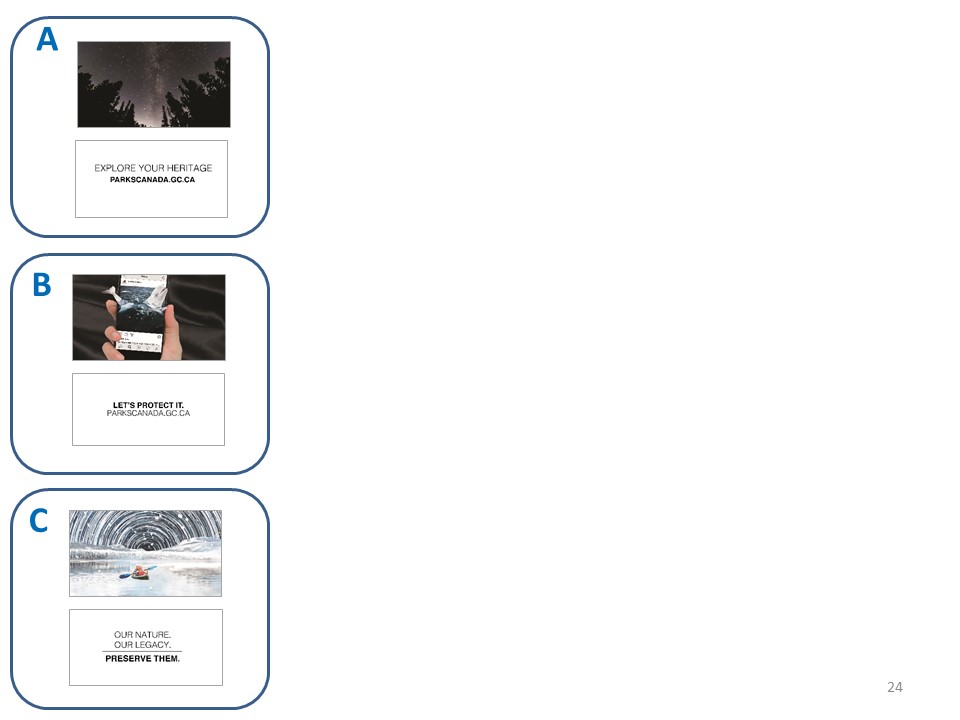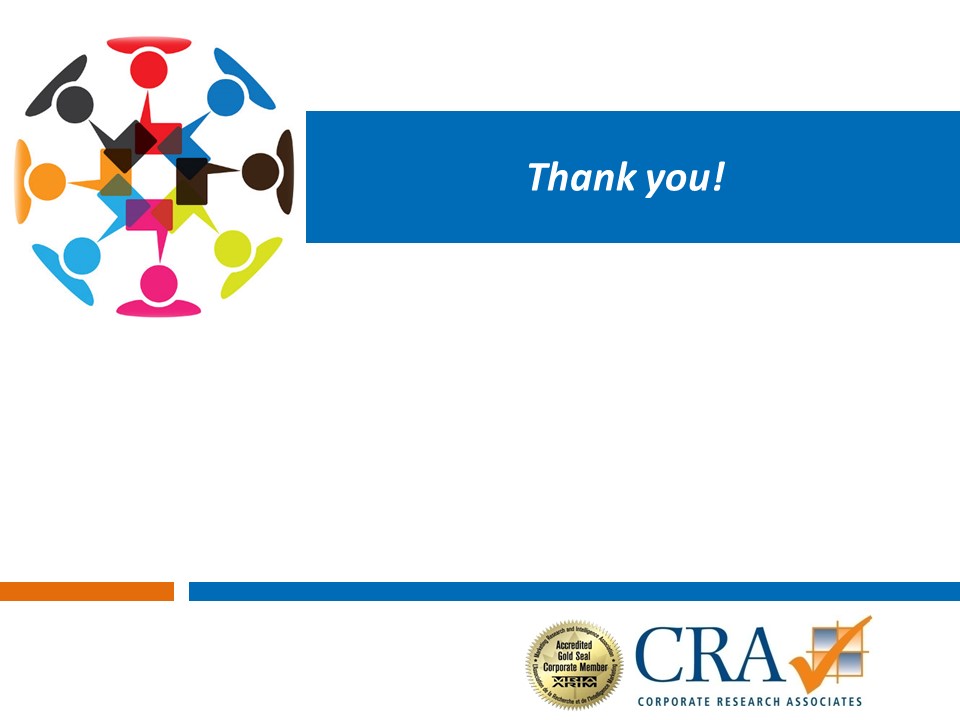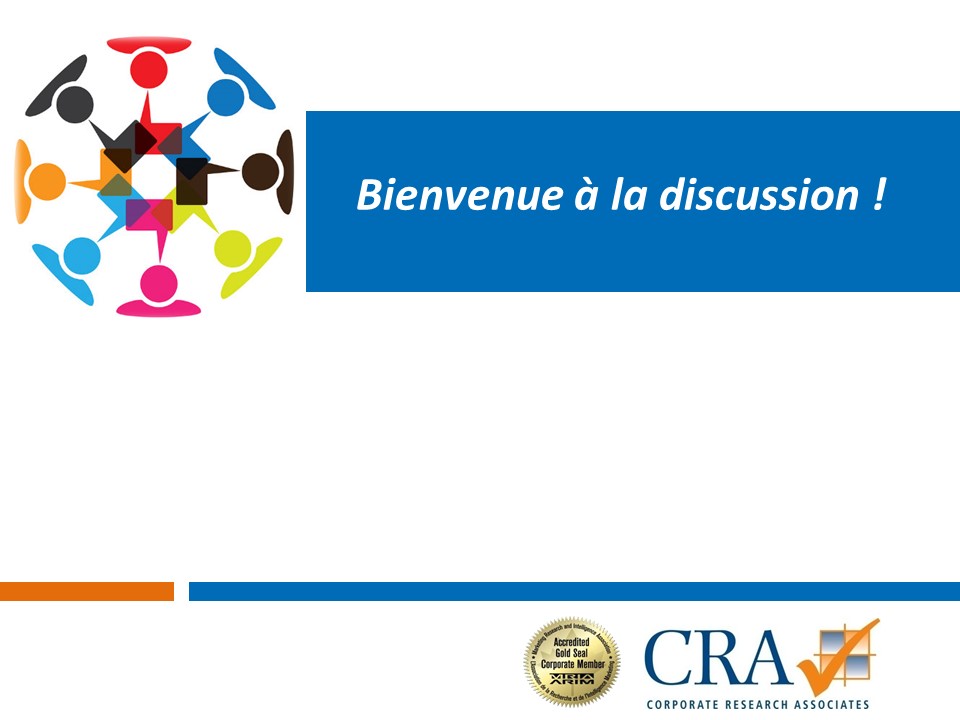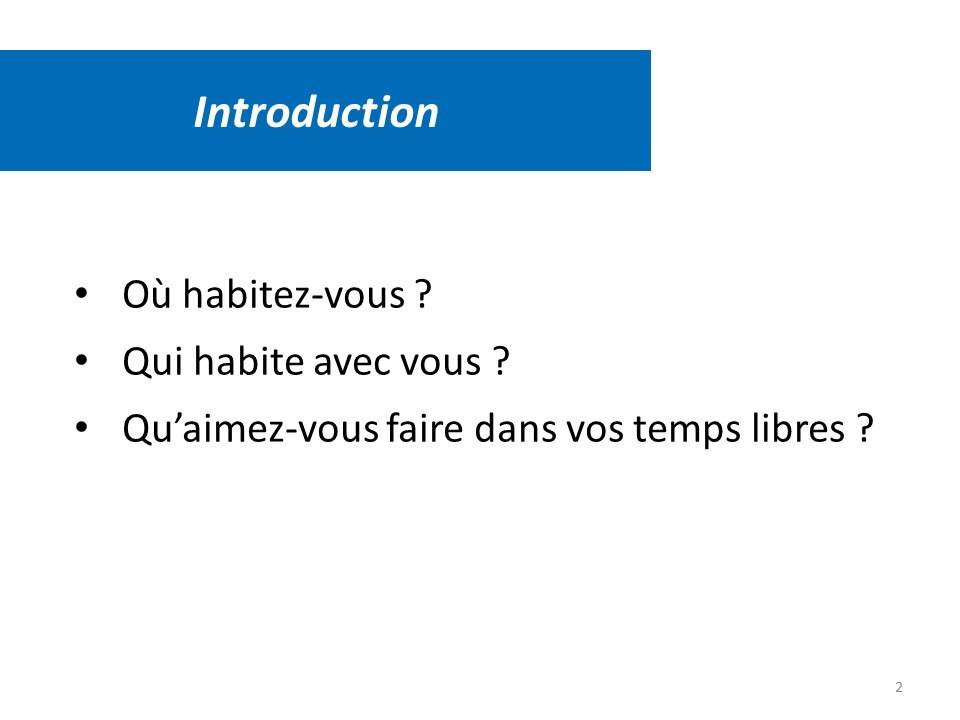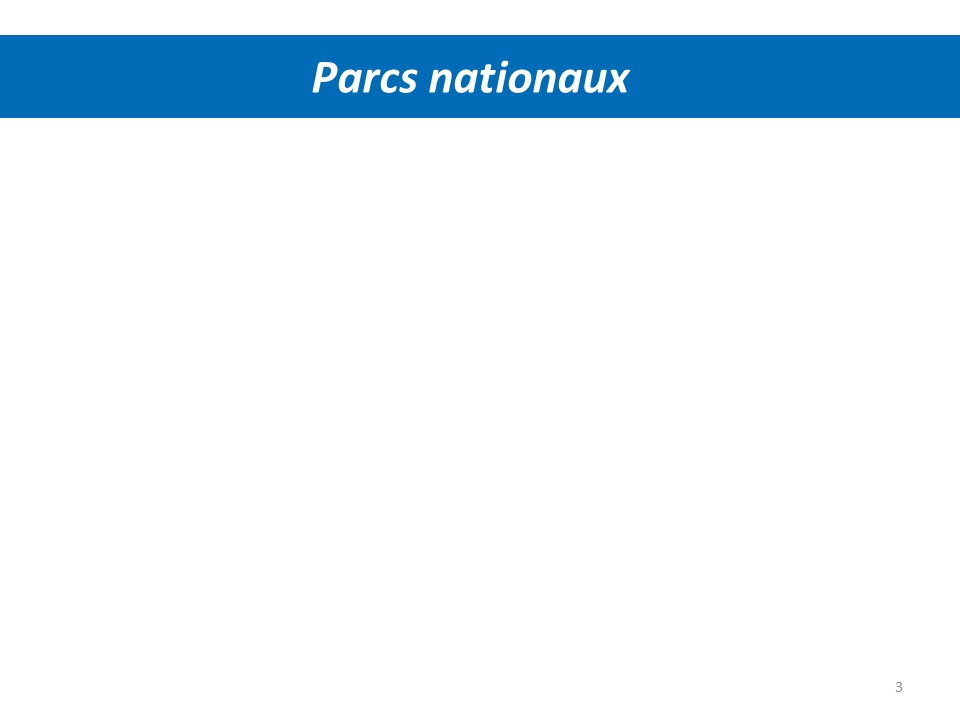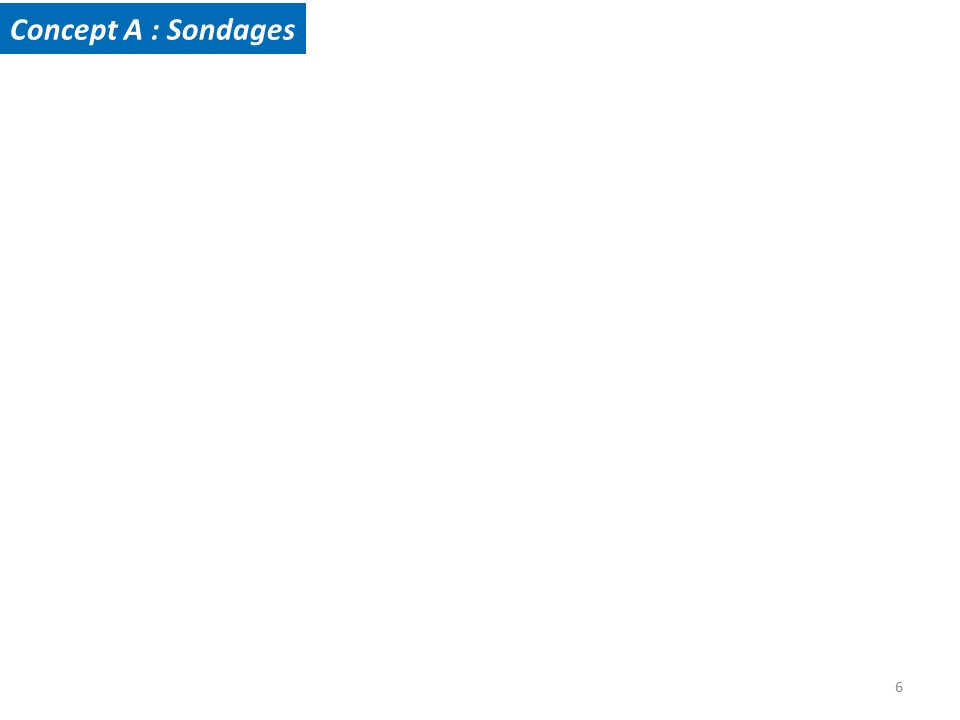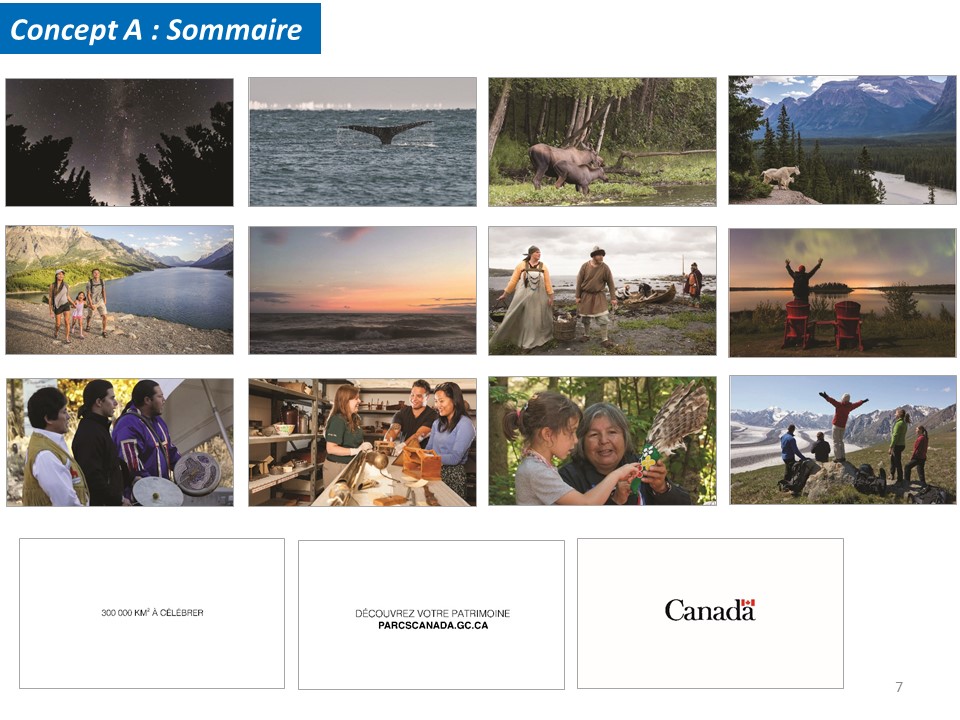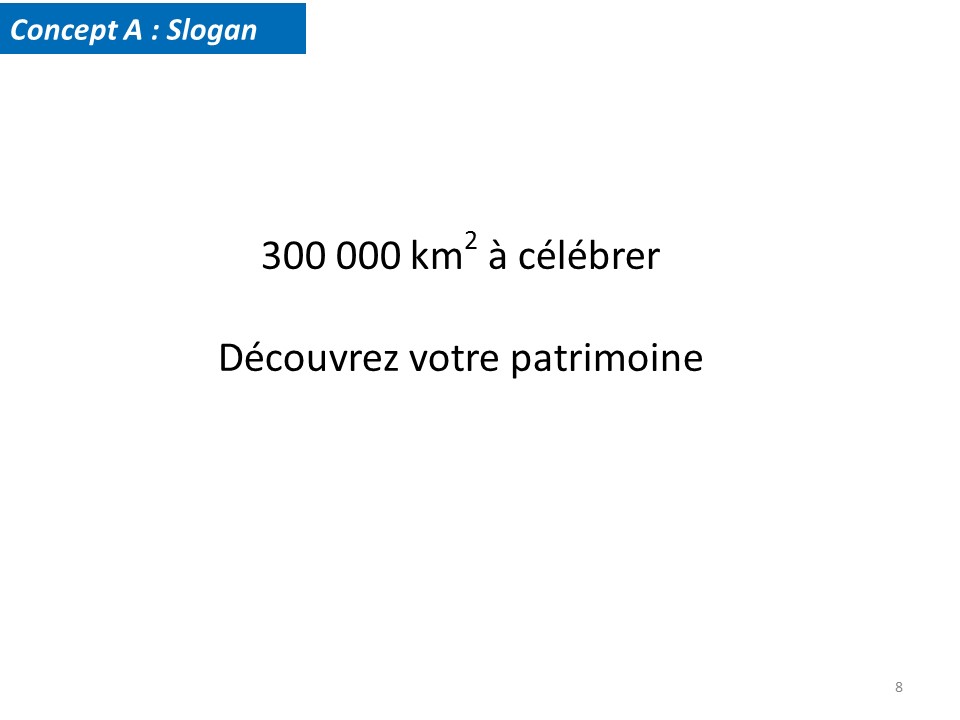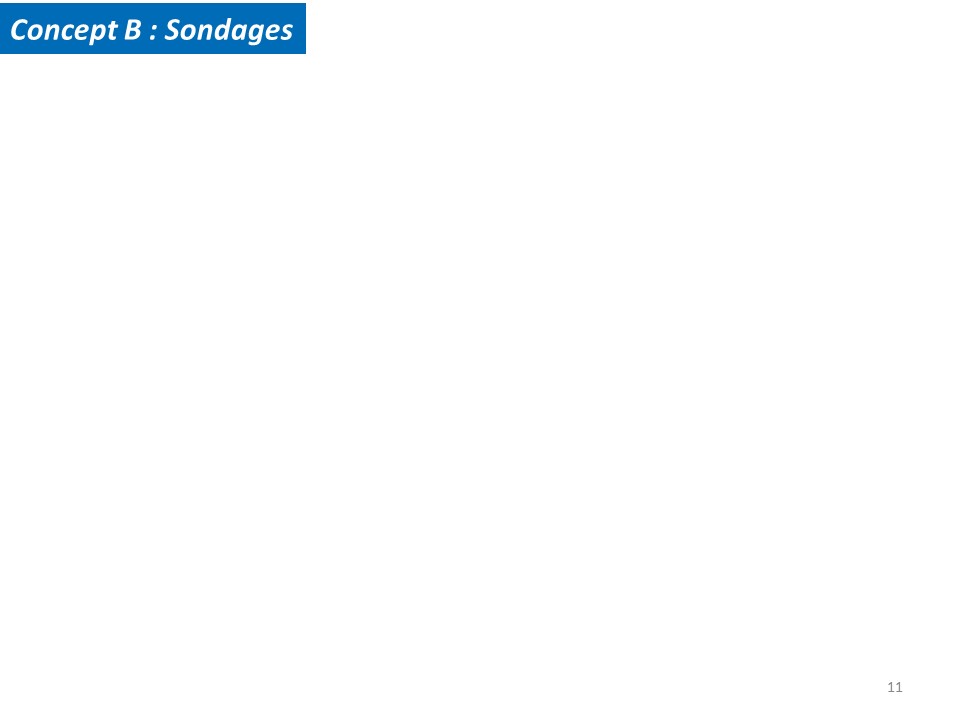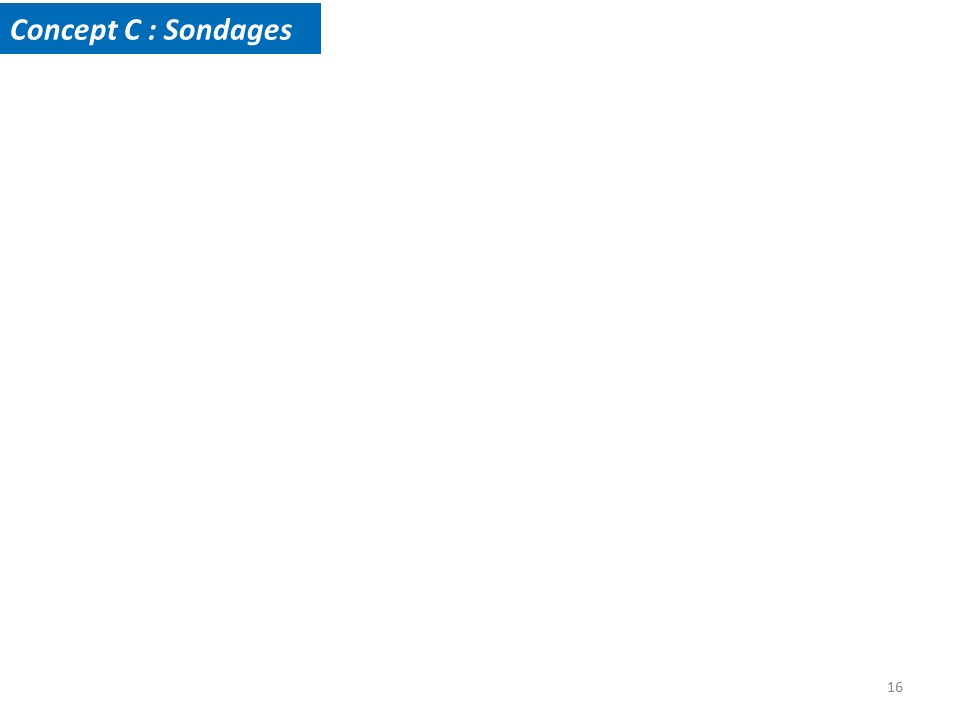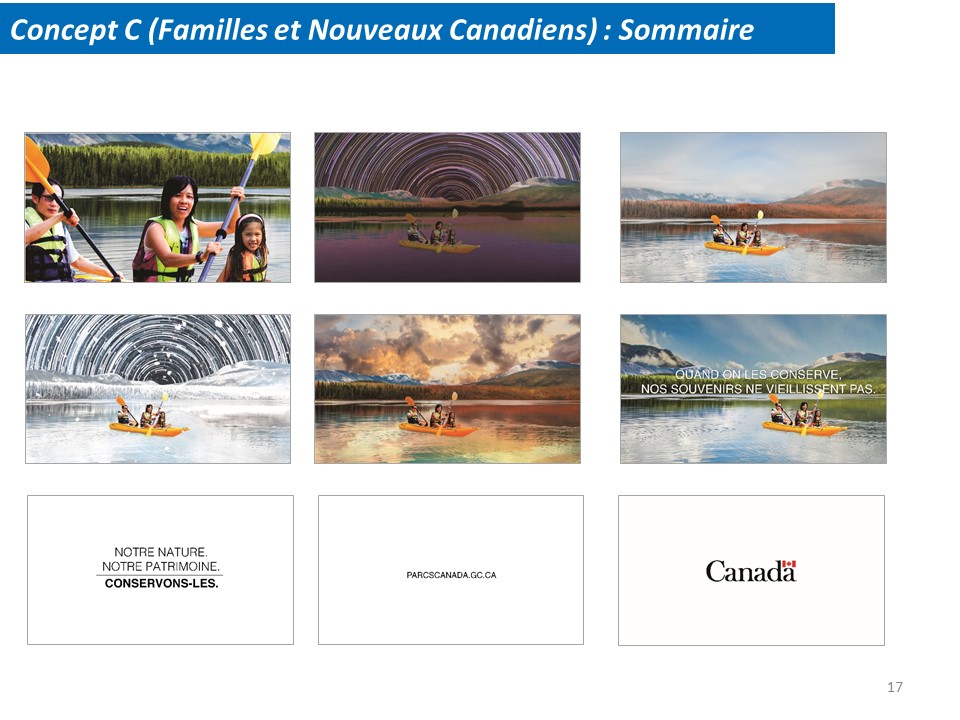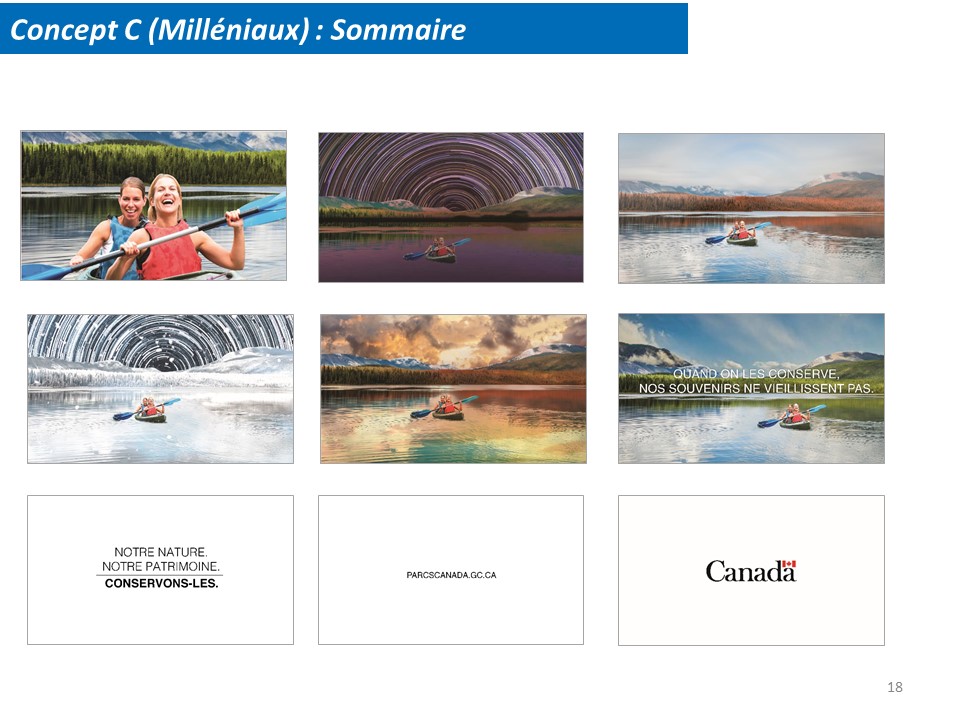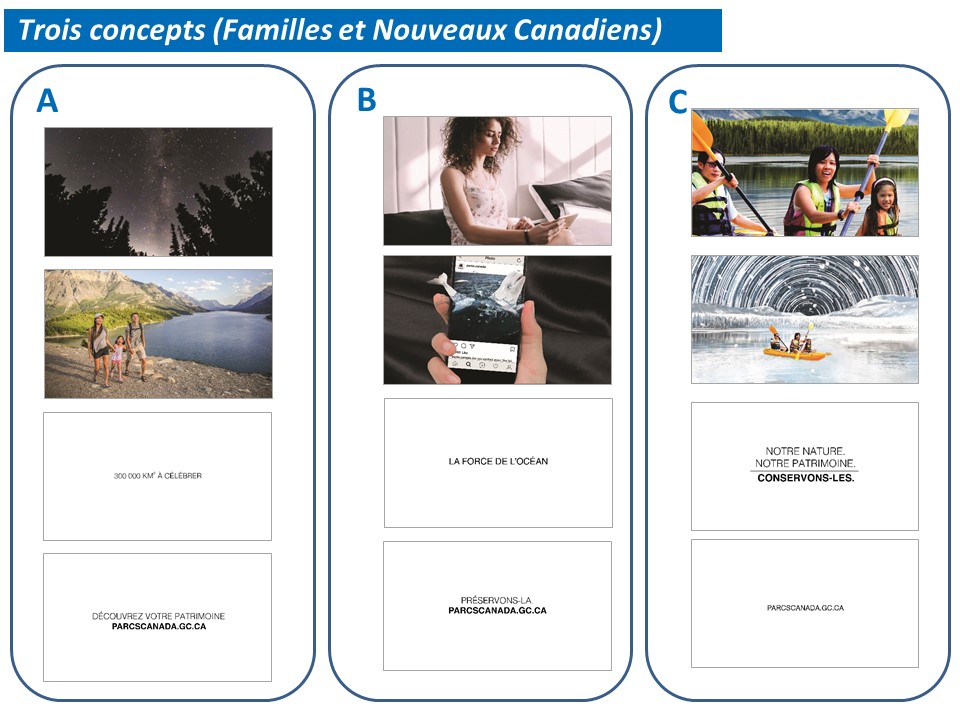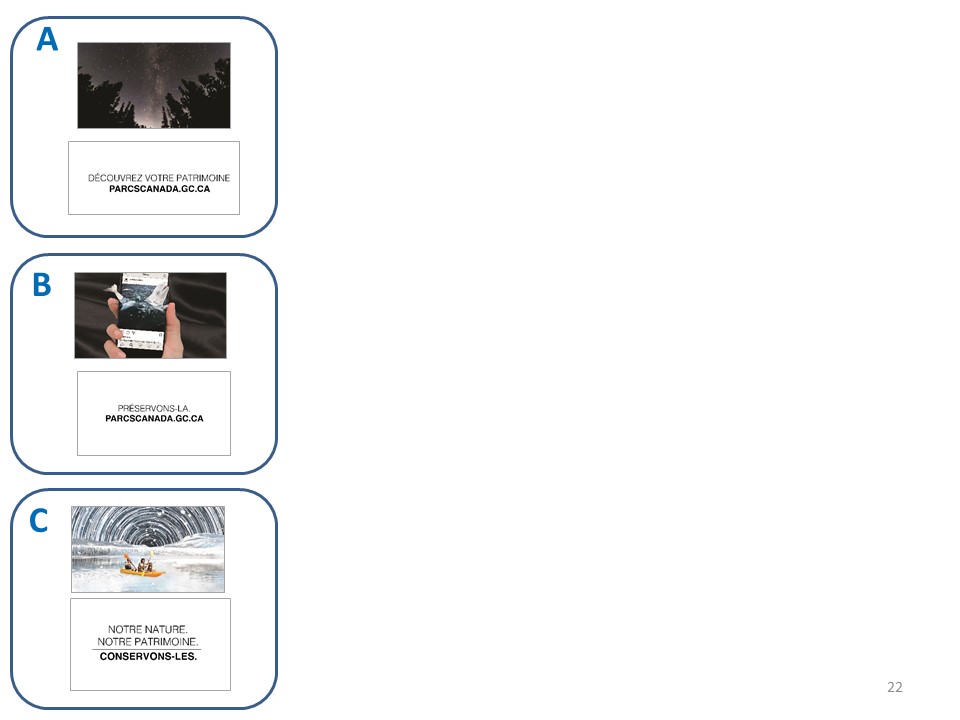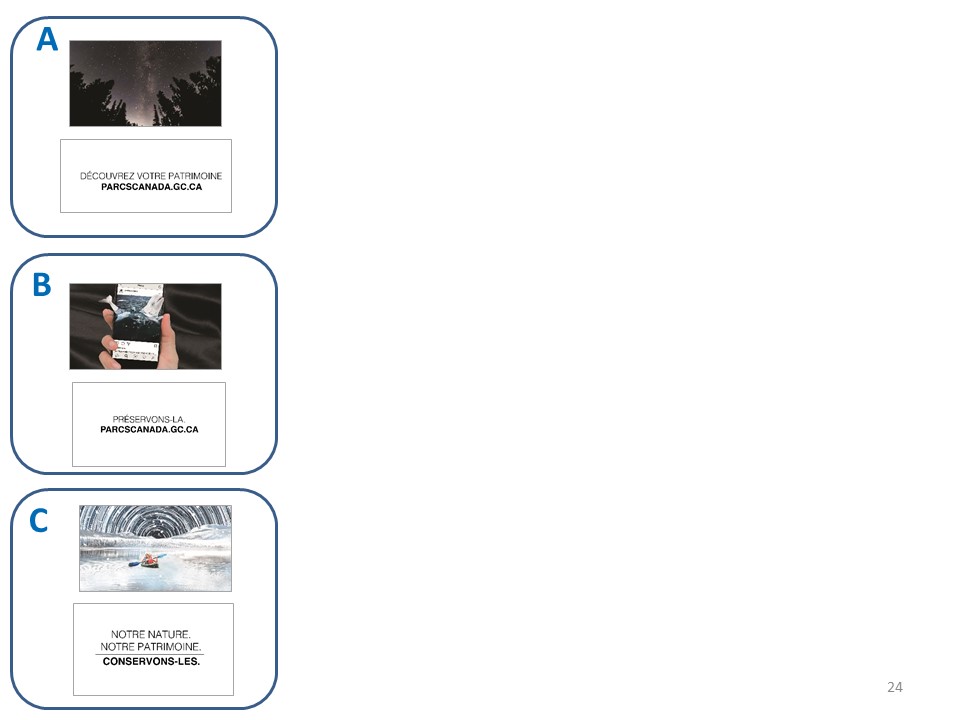Concept: Anthem




POR Registration Number: 039-17
PWGSC Contract Number: 5P047-170461/001/CY
Contract Award Date: October 17, 2017
Delivery Date: February 6, 2018
Prepared for Parks Canada Agency
30 Victoria Street, Gatineau QC, J8X 0B3
information@pc.gc.ca
1-888-773-8888
Prepared by Corporate Research Associates
7071 Bayers Road, Suite 5001
Halifax NS B3L 2C2
www.cra.ca
1-888-414-1336
Ce rapport est aussi disponible en français.
Corporate Research Associates undertook the Advertising Concept Pretesting 2017–2018 National Campaign on behalf of Parks Canada. The research aimed to assess citizen reactions to proposed creative concepts being considered for a new national campaign, to ensure the concepts resonate with the target audiences, motivate residents to consider visiting Canadian national parks and historic sites in 2018, and create national awareness and pride of Canada’s natural and cultural heritage. A total of nine online focus groups (real-time, over the phone and online) were conducted across Canada on December 6th and 7th, 2017. Six to nine participants attended each group (68 total participants), with each discussion lasting approximately 90 minutes. Parks Canada plans to use the results of the study to revise the campaign’s creative concepts before launching it across multiple media platforms in 2018.
Research findings show that none of the three concepts tested effectively address the campaign objectives, although the Anthem concept holds greater appeal and is best at conveying the message of building long-lasting memories at National Parks, as well as motivating visitation, eliciting pride in Canada’s National Parks, and conveying a conservation message. That being said, none of the three concepts effectively communicates the conservation message, in part due to a lack of understanding of the need for conservation and the unclear link between visitation and conservation.
If one of the three concepts tested is further developed, consideration should be given to choose the Anthem concept, with some modifications. Although deemed a more predictable creative approach and one typically associated with government advertisements, this concept had the widest appeal and the strongest brand identification. Despite showing diversity, its focus on history and heritage created confusion about the focus on National Parks visitation and conservation. As such, showing more outdoors activities associated with National Parks (e.g., swimming, camping, hiking, canoeing) may help strengthen the concept’s focus. At the same time, more visuals of people interacting with nature should be shown and the locations featured should be identified (either National Parks or provinces where they are located) to inform viewers and underscores Canada’s diversity.
This concept was best at representing Canadian icons, such as its scenic beauty and grandeur, as well as featuring its people’s values (respect, pride, inclusion). With this in mind, Parks Canada should ensure that the narrative remains humble and aligns with the visuals shown, and consider reducing its length for added clarity. The original and alternate taglines held appeal but were deemed problematic. Consideration should be given to changing the tagline to, “300,000 km2 worth exploring. Celebrate our heritage”.
While the originality of the creative approach of the Time Lapse concept was appreciated, the time-lapse special effect held mixed appeal. While the passing time effect related to memory building and implied that National Parks can be used year-round, it caused confusion when combined with a seasonal activity, such as kayaking. At the same time, the single focus of this concept – one activity, one family type, one location – did not properly convey the diversity participants readily associate with National Parks. At the same time, the choice of activity and setting did not strongly align with preconceived perceptions of National Parks, thus weakening brand recognition. The credibility of the tagline was questioned, as both memories and nature are viewed as being in constant evolution over time. A suggestion was made to use another tagline, namely “When preserving them, memories last forever. Let’s help our National Parks stand the test of time” to better align with the creative and strengthen brand identification.
Finally, the Technology concept was deemed the least effective at meeting campaign objectives. Given that the creative approach and use of technology implied a narrow target audience (young adult), this concept should be avoided for the current campaign, despite its originality. The focus on technology overshadowed the focus on nature, creating message confusion. This was further exacerbated by the lack of clearly identifiable National Parks icons in the visuals (e.g., inland natural settings, impressive scenery). Altogether, these elements created message confusion, with some believing that this was an ad for communication devices (smartphone or app) or to promote specific outdoors activities. While some believed it suggested that National Parks are easily accessible, others felt it implied that you can learn about or experience National Parks online without having to visit in-person. Only a few felt the concept invited viewers to leave technology behind and go experience National Parks in-person. The use of the words ‘force’ or ‘power’ in the tagline was problematic, as it references extreme natural occurrences (e.g., hurricanes, heavy rain) which cannot be controlled, and do not need protection. Words such as, ‘grandeur’, ‘beauty’, or ‘wonder’ were deemed more appropriate.
The Advertising Concept Pretesting Study employed qualitative techniques which are used in marketing research as a means of developing insight and direction, rather than collecting quantitatively precise data or absolute measures. Due to the inherent biases in the technique, the data cannot be projected to any universe of individuals. Qualitative discussions are intended as moderator-directed, informal, non-threatening discussions with participants whose characteristics, habits and attitudes are considered relevant to the topic of discussion.
Research Firm: Corporate Research Associates
Contract Number: 5P047-170461/001/CY - Qualitative
Contract Award Date: October 17, 2017
Contract Value: $45,188.70 (including HST)
I hereby certify as Senior Officer of Corporate Research Associates that the deliverables fully comply with the Government of Canada political neutrality requirements outlined in the Communications Policy of the Government of Canada and Procedures for Planning and Contracting Public Opinion Research. Specifically, the deliverables do not include information on electoral voting intentions, political party preferences, and standings with the electorate or ratings of the performance of apolitical party or its leaders.

Margaret Brigley, President & COO
Corporate Research Associates
Corporate Research Associates a entrepris le prétest de concepts publicitaires de la campagne nationale 2017–2018 au nom de Parcs Canada, une étude qui a pour but d’évaluer la réaction des citoyens face à différents concepts envisagés pour la promotion d’une nouvelle campagne nationale. L’objectif de cette initiative consiste à s’assurer que les concepts interpellent bien leurs publics cibles, poussent les résidents à envisager d’aller visiter les parcs et lieux historiques nationaux du Canada en 2018 et sensibilisent les gens à ce qui existe au pays, en plus d’accroître leur fierté à l’égard du patrimoine naturel et culturel canadien. En tout, neuf groupes de discussion ont été tenus en temps réel, à la fois au téléphone et en ligne, à l’échelle du Canada, les 6 et 7 décembre 2017. Chaque groupe était composé de six à neuf participants, pour un total de 68 participants, et les discussions ont duré environ 90 minutes. Parcs Canada a l’intention d’utiliser les résultats de cette étude afin de réviser les concepts publicitaires de la campagne avant de procéder au lancement de celle-ci dans divers médias en 2018.
Le projet a révélé qu’aucun des trois concepts à l’étude ne parvenait efficacement à atteindre les objectifs de la campagne. Toutefois, le concept de l’hymne était le plus attrayant des trois ainsi que celui qui parvenait le mieux à transmettre son message, à savoir encourager les gens à venir se créer des souvenirs qu’ils n’oublieront pas de sitôt dans les parcs nationaux, les pousser à visiter les sites, les rendre fiers des parcs du Canada et promouvoir la conservation. Si aucun des trois concepts n’arrive à communiquer efficacement un message de conservation, c’est entre autres parce que les gens ne comprennent pas ce pour quoi la conservation est nécessaire et parce que le lien entre la visite d’un parc et la conservation leur semble vague.
Si l’un des trois concepts à l’étude devait être développé, il serait recommandé d’opter pour le concept de l’hymne et d’y apporter quelques modifications. Malgré son approche prévisible et typique des publicités du gouvernement, il s’agissait du concept le plus attrayant ainsi que celui dont l’identification de marque était la plus forte. De plus, même s’il affichait une certaine diversité, le fait qu’il mette l’accent sur l’histoire et sur le patrimoine rendait vague le lien entre visite des parcs nationaux et conservation. À ce titre, il pourrait être intéressant d’augmenter le nombre d’images d’activités en plein air associées aux parcs nationaux, comme la natation, le camping, la randonnée pédestre et le canot, car cela pourrait aider à redéfinir l’objectif du concept. Dans le même ordre d’idées, il faudrait accroître le nombre d’images de gens qui interagissent avec la nature et identifier les sites illustrés (en inscrivant soit le nom des parcs nationaux, soit la province où ils se situent) : cela permettra de fournir de plus amples renseignements au public et de souligner la diversité du paysage canadien.
Le concept de l’hymne était aussi celui qui représentait le mieux les caractéristiques reconnues du Canada, comme la beauté impressionnante de ses paysages, ainsi que les valeurs de sa population (respect, fierté, inclusion). Parcs Canada devra garder tout ceci en tête et veiller à ce que la narration demeure humble et suive les images; un certain raccourcissement de la narration pourrait également en renforcer la clarté. Les deux slogans proposés étaient attrayants, mais tout de même problématiques. Ainsi, il faudrait envisager de transformer le slogan de manière à ce qu’il aille comme suit : « 300,000 km2 worth exploring. Celebrate our heritage » (300 000 km2 à découvrir. Célébrez notre patrimoine).
L’originalité du concept du temps qui s’écoule a bien été aimée, mais ses effets spéciaux n’ont pas été très populaires. Certes, le temps qui s’écoule peut avoir un lien avec la création de souvenirs et signifier que les parcs nationaux sont intéressants à longueur d’année, mais dans ce cas-ci, les participants n’ont pas vraiment compris le concept quand il était combiné avec une activité saisonnière comme le kayak. Notons aussi que de l’avis des participants, ce concept était trop concentré sur une seule activité, un seul type de famille et un seul site, ce qui ne communiquait pas adéquatement la diversité qu’ils associent volontiers aux parcs nationaux. De plus, le choix d’activité et de cadre n’allait pas tout à fait de pair avec les idées que les participants avaient des parcs nationaux, ce qui a affaibli la reconnaissance de la marque. La crédibilité du slogan a également été remise en question, car les gens étaient d’avis que les souvenirs et la nature évoluent toujours au fil du temps. Il a été suggéré d’employer un autre slogan, « When preserving them, memories last forever. Let’s help our National Parks stand the test of time » (Quand on les conserve, nos souvenirs ne s’effacent jamais. Aidons nos parcs nationaux à résister à l’épreuve du temps), qui serait mieux harmonisé avec le concept et renforcerait l’identification de la marque.
Enfin, le concept de la technologie est celui qui parvenait le moins à atteindre les objectifs de la campagne. Bien qu’originale, son approche, avec notamment l’emploi de la technologie, semblait viser presque exclusivement les jeunes adultes. Il faudrait donc l’éviter dans le cadre de cette campagne. De plus, en mettant l’accent sur la technologie, l’importance accordée à la nature semblait remise au second plan, ce qui a rendu les messages vagues. Ce manque de clarté était empiré par l’absence de parcs nationaux faciles à reconnaître (cadres naturels de l’intérieur des terres, paysages impressionnants, etc.). Ensemble, les différents éléments ont obscurci le message : certains participants ont cru qu’il s’agissait d’une publicité de technologies de communication (téléphone intelligent ou application), ou alors d’un message de promotion de certaines activités en plein air spécifiques. Certains ont compris que le message vantait l’accessibilité des parcs nationaux, tandis que d’autres ont eu l’impression qu’on leur disait qu’il était possible de s’informer sur les parcs nationaux, voire de les découvrir, en ligne, sans devoir y aller en personne. Seuls quelques-uns ont senti que le concept les invitait à mettre leurs appareils de côté pour aller visiter un parc national. L’emploi du mot « force » (ainsi que « power », en anglais) présentait lui aussi des problèmes, car c’est un mot qu’on associe facilement aux manifestations extrêmes de la nature comme les ouragans et les pluies torrentielles, des événements incontrôlables qui n’ont pas à être protégés. D’autres termes comme « grandeur », « beauty » (beauté) et « wonder » (merveille) ont semblé plus appropriés.
L’étude de prétest de concepts publicitaires a eu recours à des techniques qualitatives généralement utilisées en étude de marché dans le but de fournir orientation et compréhension d’une situation, et non d’obtenir des données quantitatives précises ou absolues. En raison des distorsions propres à cette technique, les données ne doivent pas être extrapolées sur une population précise. Les discussions qualitatives se veulent des discussions détendues et non menaçantes dirigées par un animateur, et regroupant des participants qui présentent des caractéristiques, des habitudes et des attitudes qui sont jugées pertinentes dans le contexte du sujet traité.
Société de recherche : Corporate Research Associates
Numéro de contrat : 5P047-170461/001/CY – étude qualitative
Date d’octroi du contrat : le 17 octobre 2017
Valeur contractuelle : 45 188,70 $ (TVH incluse)
J’atteste par la présente et à titre de cadre supérieur de Corporate Research Associates Inc. que les résultats attendus sont entièrement conformes aux exigences en matière de neutralité décrites dans la politique de communication du gouvernement du Canada ainsi que dans les procédures de planification et d’attribution de marchés de services de recherche sur l’opinion publique. Plus précisément, les résultats attendus n’incluent pas de renseignements sur les intentions de vote électoral, les préférences quant aux partis politiques ou les positions des partis, et les cotes de performance d’un parti politique ou de ses dirigeants.

Margaret Brigley, Présidente et chef des opérations
Corporate Research Associates
Parks Canada is currently developing a national tourism campaign that will span the next two years. The campaign aims to inspire Canadians to visit National Parks in 2018 using their Discovery Pass, in addition to developing national awareness and pride of Canada’s natural and cultural heritage. To assist the final development of this campaign, Parks Canada was interested in assessing citizen reactions to the proposed creative concepts being considered to ensure they resonate with the target audiences and clearly communicate the intended message.
To assess opinions, perceptions and overall reactions to the proposed creative concepts, Parks Canada commissioned Corporate Research Associates to conduct a series of online focus group discussions across the Country with adult Canadians.
Specific objectives of this research included:
Ultimately, the research findings will inform the final advertising material that will be launched in early 2018.
In December 2017, Corporate Research Associates undertook the Advertising Concept Pretesting – 2017–2018 National Campaign on behalf of Parks Canada. This qualitative research included a series on online focus group discussions with adult Canadians. More specifically, a total of nine (9) online focus groups (over the phone and online, simultaneously in real-time) were conducted (6 in English and 3 in French) over a two-day period, December 6th and 7th, 2017. Each group discussion lasted approximately one hour and thirty minutes, and as per market standards, participants each received $75 in appreciation of their time and input.
Three audiences were included in the study, namely:
The following outlines the geographical coverage of groups conducted by language and audience:
Across all groups, 68 participants took part in the study. Further, in each group, participants included those who expressed some level of interest in national parks, the outdoor and/or cultural settings, and those who believed in the importance of protecting Canada’s nature areas and historic sites. At least half of participants did not identify Parks Canada by name as being the organization or government department that operates officially designated National Parks and National Historic Sites of Canada. In terms of the demographic profile of participants, each group included a mix of employment status, education, and household income, where possible. All participants had access to a computer with high speed Internet to take part in the session. As is normal practice in market research, those who work in or are retired from specific industries, or who have someone in their household in this situation, were excluded from the study. These industries include market research, marketing, public relations, media, advertising, political parties, government department (provincial and federal) related to tourism, parks, or the environment, and nature parks. All participants were recruited from qualitative general population panel lists and random dialing.
All groups were conducted by experienced and professionally-trained moderators. For this project, two moderators were used based on linguistic capability, the need to conduct multiple groups across Canada within the same week, and within certain timeframes.
The following conclusions are provided for Parks Canada’s consideration, based on the findings of the Advertising Concept Pretesting – 2017–2018 National Campaign.
None of the three concepts tested strongly communicate the conservation message.
While all three campaigns conveyed the primary campaign message (i.e. encouraging visitation), none effectively communicated the conservation message. In fact, the relationship between both visitation and conservation was unclear, thus leading to a weak call to action. At the same time, questions were raised regarding the need to focus attention on conservation of National Parks, given their particular status as government-protected and designated areas. Again, none of the concepts effectively explain these relationships.
The Anthem concept most clearly communicates the campaign’s intended messages and has the strongest call to action.
Although considered a ‘safe’ and predictable creative approach for government, the Anthem concept outperformed the other two concepts at meeting the campaign objectives. For the most part, the diversity illustrated in the video and the inspirational tone grabbed attention, elicited a positive emotional response (pride, inspiration) and contributed to its wider appeal. The target audience was viewed as being all Canadian residents, though the concept did not strongly resonate with the target audiences.
This creative approach performed relatively well at encouraging visitation and effectively suggested that experiencing National Parks will create long-lasting memories, although the Time Lapse concept was also considered effective in that regard. The primary message was understood as the promotion of Canada’s culture and heritage in general, more so than of National Parks in particular. While the Anthem concept was deemed best at showing the importance of conserving Canada’s national natural parks, it did not properly explain why this is necessary and how it can be done. The celebratory message and tone was reminiscent of Canada 150 celebrations, thus suggesting an invitation to discover everything that Canada has to offer.
For the most part, the concept was lauded for its inclusion of diversity in terms of landscape, geography, people, wildlife, and to a lesser extent, activities, and for effectively speaking of two key Canadian characteristics, namely its breathtaking scenery and its people. The use of narration also helped keep the viewers’ attention. That being said, the concept was considered lacking creativity, not adequately illustrating outdoors action-oriented activities expected at National Parks (camping, canoeing, swimming and hiking), and did not properly explain how history, heritage, and culture relate to National Parks. The visuals featured in the video appeared more representative of Western Canadian provinces to French-speaking participants than of Quebec’s natural settings. In some instances, the narrative did not align with the image shown and Millennials found the narrative lacked personal relevance.
The tagline, “300,000 km2 worth celebrating. Explore your heritage” was well received, illustrated the vastness of the Country, and effectively acted as an invitation to explore and discover Canada’s heritage. The alternate tagline, “300,000 km2 worth exploring. Protect your heritage” was less appealing primarily due to the word ‘protect’ being too forceful and authoritative. Consideration should be given to merging both tagline to become “300,000 km2 worth exploring. Celebrate our heritage” to make it more personal and stress the visitation message.
The Time Lapse concept spoke of protecting memories, but failed to meet the other campaign objectives. This creative approach held mixed appeal.
Although the Time Lapse effect suggested that experiencing National Parks will create long lasting memories, the concept failed at motivating visitation, eliciting pride in Canada’s National Parks, and showing the importance of conserving Canada’s natural parks. Brand recognition was weak due to the lack of recognizable Parks Canada identifiers or unique characteristics in the visual or narrative.
The main message was identified as an invitation to spend time exploring National Parks year-round to create long-lasting memories, although the message is only clarified with the tagline that is shown at the end of the video. The target audiences aligned more closely to the type of individuals shown in each video, though primarily including those that enjoy the outdoors.
On a positive note, the originality of the creative approach piqued viewers’ interest, and the video conveyed that National Parks are accessible year-round. That being said, the Time Lapse approach was not always understood in the context of a National Park visit, especially when combined with an activity that is usually aligned with a specific season (i.e., kayaking in the summertime). At the same time, the concept’s narrow focus, presenting only one aspect of National Parks and one type of audience, did not represent the diversity associated with National Parks, even if a family of ads is developed as part of this campaign. The call to action was weak.
The tagline, “When we preserve them, memories never get old. Our nature. Our legacy. Preserve them” was deemed too wordy and lacking credibility. Memories were seen as changing over time as people get old, and nature was considered as being in constant evolution, thus also changing over time. The alternate tagline, “Memories never grow old. Let’s help nature stand the test of time too” also lacked credibility. Both taglines did not effectively identify or relate to Parks Canada. A tagline was suggested by participants, namely “When preserving them, memories last forever. Let’s help our National Parks stand the test of time” to better align with the creative and strengthen the concept’s brand identification.
Despite its unique creative approach, the Technology concept caused message and brand confusion and failed to elicit the desired call to action.
Despite the unique and youthful creative approach for this concept being well-liked, and its realistic reflection of society’s use of technology, it elicited brand and message confusion. The concept was deemed as the least effective at implying that visiting National Parks creates long-lasting memories, and at stressing the importance of conservation. It was also least likely to motivate National Park visitation or elicit pride in Parks Canada’s sites.
This concept elicited message confusion due to the lack of clear identification of National Parks or Parks Canada prior to the end of the ad. The scenario focused on the technology “coming to life”, thus suggesting to some an advertisement that demonstrates the quality of a smartphone or an app. Focused attention on the ocean contributed to the brand confusion, as National Parks are primarily associated with in-land natural environments. Finally, the visuals do not uniquely speak of National Parks.
When combined with the tagline and brand identification, this creative approach still caused some confusion. It was believed that the ad implied the close locations and accessibility of National Parks, or the ability to learn about or experience National Parks online. To a lesser extent, the concept extended an invitation to leave technology behind and go experience National Parks in-person. Because of the use of technology, young adults were seen as the primary audience and Millennials also voiced more positive comments regarding this concept than other audiences included in the research.
The tagline, “The force of the ocean/nature/history. Let’s protect it” lacked appeal or relevance, primarily due to the use of the expression ‘force of…” which is associated with extreme natural events that cause fear (e.g., storms, hurricanes, heavy rains) rather than nature’s positive strengths. It was felt that the forces of nature need controlling, not protection. The alternate version, “Discover the power of the ocean/nature/history and the means to preserve it” was preferred, as it encourages action. That said, the word ‘power’ akin to the word ‘force’ was still deemed inappropriate and words such as ‘grandeur’, ‘beauty’, or ‘wonder’ should be considered. Finally, the tagline “Let go of your phone and go live it in real time” lacked personal relevance, sounded too authoritative, and was repetitive with the message conveyed in the scenario.
As Parks Canada moves forward with the development of its 2017–2018 National Campaign, the following recommendations derived from the analysis of the study findings should be considered.
The discussion began with a brief overview of participants’ national park experiences in Canada in the recent past. For the most part, participants in each group have visited at least one national park in the past few years to enjoy outdoor activities such as hiking, camping, and nature watching. Those living closest to national parks were most inclined to have visited recently, and reported more frequent visits.
Many participants experienced difficulty differentiating National Parks from regional or provincial parks. Some of the National Parks, however, were more readily recognized, such as Banff National Park and Jasper National Park. Other National Parks identified include, Cape Breton Highlands, Gros Morne, Bruce Peninsula, and Mingan Archipelago National Park Reserve. In addition, many Quebec participants mentioned having been to the Plaines d’Abraham which was considered a national protected site, while one participant mentioned having been to the Saguenay-St. Lawrence Marine Park.
In looking at these findings, it should be noted that participants were recruited among individuals who are interested in national parks, the outdoors, and cultural settings, with most being unable to identify Parks Canada by name as the organization or government department that operates officially designated National Parks and National Historic Sites of Canada.
None of the three concepts tested strongly communicate the conservation message.
Participants were shown three concepts for an advertising campaign for National Parks in Canada. Each campaign included one video animatic for the purpose of testing that represented a 30-second video for television, movie theatres, or online applications. The campaign material was presented as draft only, and the order of presentation was rotated across groups to avoid order biases. For each concept, two or three alternatives for a tagline were also discussed. During the presentation of the creative, participants were asked to consider that if a campaign is finalized, it would include a number of different videos within the same theme. Throughout this report, the campaigns are referred to as “Anthem”, “Technology”, and “Time Lapse”, for ease of reference.
While each concept is discussed in detail in the next sections of the report, it should be noted that across groups and audiences, there was a sense that none of the three concepts tested strongly communicated the importance of protecting national natural parks. In fact, this was seen as a secondary message to encouraging park visitation. No concept effectively explained the need (i.e., reasons) for conservation of these areas or how Canadians can make that happen. Participants were left questioning the need to protect natural parks they consider already receive government protection as designated areas, often expressing their lack of awareness of specific issues that need to be addressed. At the same time, the concepts were not seen as having a strong call to action related to conservation, leaving viewers unsure of what they can do.
The following sections present detailed findings from the discussion pertaining to each of the three concepts.
The Anthem concept most clearly communicates the campaign’s intended messages and has the strongest call to action.
Of the three campaigns tested, the Anthem concept was consistently considered to be the best at showing the importance of conserving Canada’s national natural parks, eliciting pride in Canada’s National Parks, and encouraging National Park visitation. It was also the most likely to suggest that experiencing National Parks will create long-lasting memories, although the Time Lapse concept was also noted in that regard.
This concept did not elicit strong reactions from participants, and it was generally considered a ‘safe’ approach and a creative that would be expected from the Government of Canada. As such, it was not as attention-getting as the other two concepts. Nonetheless, the diversity of scenery and people created a sense of unity and a widespread appeal. Moreover, the use of various Canadian landscapes makes it the concept most obviously associated with Parks Canada.
“Celle-ci est trop sérieuse, je m’attendrais à un documentaire sur le patrimoine.” (This one is too serious. I would expect a heritage documentary.) Millennial
“J’ai adoré la publicité et j’ai trouvé les images très belles avec le côté historique et le côté culturel.” (I loved the ad and I found the images beautiful, with the historic and cultural side.) Parent
“This is unifying – including little pieces from across the Country.” Parent
Participants identified a number of positive attributes with this concept. Notably, it was believed that diversity is well represented in this concept, in terms of landscape, geography, people, wildlife, and to a lesser extent, activities. The scenario is also effective at illustrating some of Canada’s strengths, namely its scenic beauty and its people. The concept was deemed inclusive and showing a clear focus on life in general. The unifying and patriotic approach was also well liked. As such, this concept also elicited a greater emotional response than the other two, notably in terms of being proud of Canada.
Concept: Anthem




“On voit plusieurs images de plusieurs parcs différents; il y a une abondance de parcs.” (We see many images of many different parks. There is an abundance of parks.) Parent
“I like the blend of the activities and the scenic aspects. I think the scenery is breathtaking and makes you think about how varied the scenes are in Canada.” Millennial
“What makes people great comes from nature. This shows a diversity of people and places and tells you a lot about Canada.” Newcomer
“This is all encompassing. It’s more emotional, making me proud.” Parent
Finally, from a creative standpoint, the use of narration helped grab viewers’ attention.
“On dirait que le fait que j’étais guidé par une voix, le message était plus clair que d’avoir à deviner.” (As I was guided by a voice, the message appeared clearer than just having to guess what it is.) Millennial
Despite these positive attributes, the concept was deemed uninteresting and lacking excitement to many. The activities shown did not effectively convey the action-oriented activities participants expect to partake in at National Parks, such as hiking, canoeing, swimming, and camping. Similarly, the video lacked clear association with Parks Canada given the limited number of outdoors action-oriented visuals of activities expected at a National Park.
“It is a typical ad for Parks Canada or Canada in general. It lacks creativity. It does not stand out.” Millennial
“This is exactly what you would expect to see from Parks Canada.” Parent
While this concept referenced history, the relationship with National Parks was not clear. Indeed, participants associate National Parks with nature settings, and do not see the relevance to introduce cultural or historical references in a video that speaks of experiencing and conserving national natural parks. In a few instances, the historic image caused confusion, where some participants were not able to easily determine if it was intended to be a historic image or a modern-day reenactment. In fact, a few participants assumed that the reenactment image reflected current-day life in more remote areas of the Country, rather than a reenactment of a historic event.
French-speaking participants felt that the imagery is more akin to west-coast natural parks, where oceans and mountains are more prevalent, and thus felt less compelled by this concept. Indeed, many considered that this was an ad that featured iconic images representative of Western Canada, more so than of Quebec.
It was mentioned that in some instances, the narration does not align with the images shown (the visual of the family has a narrative about heritage). In addition, while the inclusion of narration is appreciated, this concept was considered narrative-heavy. At the same time, a few Millennials felt that the script was a bit pompous and detached from everyday life.
“The images are beautiful and breathtaking but I found the script to be a little corny.” Millennial
“Some of the dialogue doesn’t match the imagery, especially the words when the Indigenous images are shown.” Parent
This concept was viewed as inviting Canadians to visit National Parks and be proud of the Country’s offerings. To many, this video seemed more like an ad that speaks of our culture and heritage than one that speaks of natural settings. This caused some confusion regarding the campaign’s intent, as Parks Canada is more readily associated with natural parks than with culture and heritage.
“C’est quoi le but de la publicité? De nous raconter notre histoire ou de nous dire qu’on est chanceux?” (What is the purpose of the ad? To tell us about our history or to tell us we are lucky?) Parents
Some perceived this concept as conveying a celebratory message, in line with the Canada 150 celebrations. As such, it was seen as encouraging Canadians to explore their country and all it has to offer, beyond natural settings and historical sites. That being said, the concept did not strongly convey a conservation message.
“Ça m’incite plus à voyager et à découvrir mon pays. Il y a beaucoup de choses à visiter au Canada. Ça me pousse plus à aller voyager et à en apprendre plus sur des sites nationaux. Je n’ai pas vue [le message de] préservation mais plus la découverte.” (It encourages me to travel and discover my country. There are lots of things to see in Canada. It encourages me to travel and learn more about our national sites. I did not see the conservation message, but it’s more about discovery.) Millennial
“Ça me dit de découvrir le patrimoine et les parcs nationaux pour apprendre la culture et découvrir la nature. Tu peux te reconnecter avec ton propre pays. C’est vos gens, votre culture, notre histoire.” (It tells me to discover our heritage and national parks to learn about culture and discover nature. You can reconnect with your own country. It’s your people, your culture, our history.) Parent
“This doesn’t convey a message of preservation. There is nothing about conservation.” Parent
“It spoke to me a little bit. It shows lots of different landscape and different activities and cultures in Canada. It shows a lot of different things about Canada. It is just wanting to preserve the national parks. By having people come to the parks and celebrate them and visit them.” Millennial
“Explore your heritage and you are part of this so it is yours to explore.” Millennial
Because of its widespread appeal, the primary audience for this concept was considered to be all who live in Canada. Indeed, this concept was considered as appealing to a wide range of individuals, although due to its formal and promotional tone, it lacked personal relevance to some extent.
“It is speaking to Canadians and telling us how we need to preserve our history and preserve our ancestry.” Millennial
This concept elicited a variety of positive emotions, notably pride in Canada and its people. The overall approach conveyed a sense of liberty, grandeur, and space that defines the Country. It also highlighted Canadian values, such as being welcoming, sharing, and accepting of others. Moreover, many participants were left with feelings of joy and happiness after seeing the video. That being said, these positive feelings were not sufficient to make the ad personally compelling, perhaps due in part to the official government tone, combined with some message confusion.
“Être fiers de notre patrimoine, de nous, de notre Canada, des ethnies qui l’ont aidé à grandir.” (Being proud of our heritage, of us, of our Canada, of ethnic groups who helped us grow.) Parent
“With ‘explore’ or ‘celebrate’, they are words with positive connotations and they made me feel good. Happiness and a good feeling.” Millennial
Original Tagline:
300,000 km2 worth celebrating. Explore your heritage
300 000 km2 à célébrer. Découvrez votre patrimoine
The tagline was generally deemed appealing and considered as aligned with the overall concept by speaking of the expansiveness and the vastness of the Country. That said, to some, it is unclear if the 300,000 km2 refers to the size of Canada or the size of National Parks. To others, the large number in itself implied the extensiveness of Canada’s heritage.
“Il y a 300 000 km de patrimoine à découvrir dans nos parcs. C’est clair, simple et concis.” (There are 300 000 km of heritage to discover in our parks. It’s clear, simple, and concise.) Parent
The word, ‘celebrating’ further reinforced the perception of a promotional video, though when combined with the word ‘explore’, it translated into an invitation to discover Canada’s heritage. Some felt the use of the word celebrate aligned the ad with Canada’s 150th anniversary.
“’Coast to coast’ on a une immensité qui est encore à nous et qu’il faut la découvrir.” Parent
“[le titre] ‘Découvrez le patrimoine’, c’est bon et ça invite.” (It’s good to discover the heritage. It is an invitation.) Millennial
“There is a vast difference between west and east and everything in between. Everything is worth celebrating and exploring.” Millennial
“Seeing ‘celebrating’ – that’s a play on the 150th anniversary.” Parents
Meanwhile, many believed that the tagline is the only component that clearly articulates an invitation.
“Le concept met beaucoup l’emphase sur l’importance du patrimoine et la rareté mais moins sur venez nous voir. Le slogan essaie de nous attirer.” (The concept puts a lot of emphasis on the importance of heritage and uniqueness, but less on ‘come see us’. The tagline is trying to draw us in.) Parents
Alternate Tagline:
300,000 km2 worth exploring. Protect your heritage
300 000 km2 à explorer. Protégez votre patrimoine.
Participants were also shown an alternate tagline for their consideration. The alternate tagline was considered less appealing due to the use of the word, ‘protect’. Indeed, the word suggested the need to defend something or implied that a dispute or confrontation is involved. It was considered a word that is too ‘forceful’ or strong, and thus took away from the remaining messages conveyed by the statement.
“I do not like the word ‘protect’; it’s too official. Like it is the police or that, ‘you have to do this’. I prefer the first [tagline]. It’s less authoritative.” Millennial
By contrast, most found use of the word ‘exploring’ to be more action-oriented and relevant to National Parks than the word ‘celebrating’.
In one French parents group, it was mentioned that the concept of protection and exploration of natural parks appear contradictory, though this sentiment was not shared by many.
“Si on explore on ne protège plus le parc on le détruit; c’est deux mots ne vont pas ensemble.” (If we explore, we no longer protect the park, we destroy it. These are two words that do not go together.) Parent
Participants offered consistent suggestions for enhancing the two tagline options provided. More specifically, it was suggested that the word ‘your’ be replaced by ‘our’ when speaking of heritage, to ensure that it speaks to all Canadians regardless of their ethnic or cultural background, or how long they have lived in Canada. Changing this terminology was also seen as making the tagline more compelling, by referencing the viewer’s own heritage. A suggestion was made to merge both taglines into a new one that would read: “300,000 km2 worth exploring. Celebrate our heritage”.
“J’aurai mis la première phrase du deuxième avec la deuxième phrase du premier. Découvrir notre patrimoine ça nous donne le goût de le protéger. On ne peut pas protéger ce qu’on ne connait pas.” (I would merge the two statements. Discovering our heritage will make us want to protect it. We can’t protect what we are not familiar with.) Parent
“The use of ‘our’ rather than ‘your’ unifies us and better links to the images. It also speaks to Canadians who are first generation, and whose people may not be from Canada.” Parent
When asked what would establish greater personal relevance, or make the concept more effective, suggestions provided by participants included:
Concept: Family Time Lapse
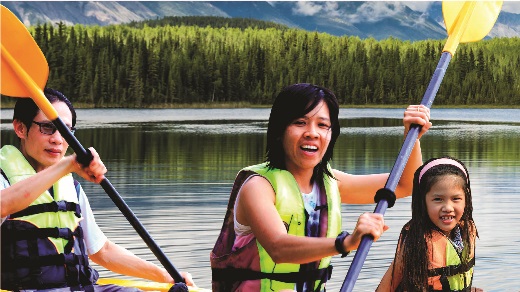
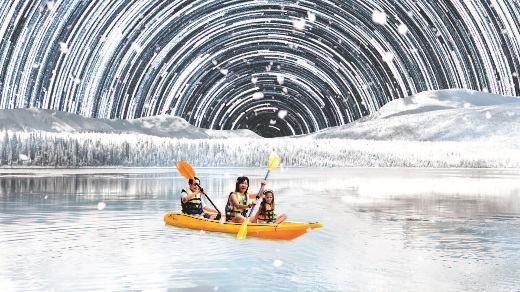
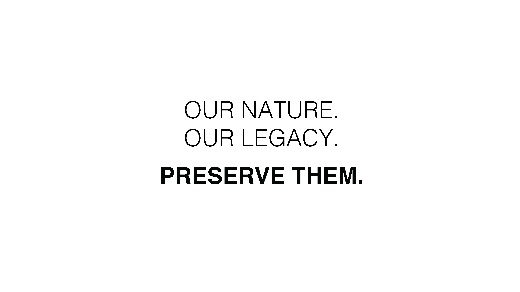

Concept: Family Time Lapse

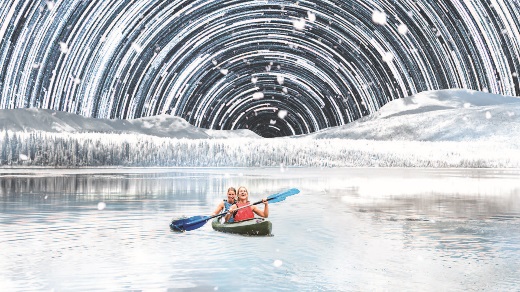


The Time Lapse concept spoke of protecting memories, but failed to meet the other campaign objectives. This approach held mixed appeal.
This section presents the main reactions to the Time Lapse concept. Families/new Canadians and Millennials were shown different versions of this concept, with each illustrating people within their respective audiences. Along with the Anthem concept, this approach was considered by some as effectively suggesting that experiencing national parks will create long-lasting memories. The Time Lapse creative approach most likely contributed to this perception. It was not considered effective at showing the importance of conserving Canada’s natural parks, at motivating visitation, or at eliciting pride in Canada’s National Parks.
There were mixed reactions to this concept, with some appreciating the time-lapse effect, while others did not understand its relevance. At the same time, the concept was not strongly associated with Parks Canada, as it does not feature recognizable scenery, nor does it speak of the variety of outdoors activities available at these sites. In a few instances, participants also questioned the relevance for the Government of Canada to stress the importance of conservation of natural areas, which suggests that the environmental risks are not well understood by the public.
“Je me suis posé la question du pourquoi ils font une publicité sur ça. On est un des pays qui a le plus de forêts qui n’est pas touchées et il n’y a pas de déforestation.” (I asked myself why [Parks Canada] is conducting an ad like this one. We are one of the countries with the most unaffected forests and there is no deforestation.) Parent
“There is a complete disconnect between the visuals and the words. It shows nothing of preservation. Real preservation should not include people in the nature.” Parent
The concept did not clearly speak of Parks Canada, and the natural setting and message communicated by the visuals was considered as applicable to any natural setting. Only at the end are viewers clearly informed of the ad’s sponsor. It was mentioned that the idea lacks wildlife and other features of National Parks to more clearly identify the diversity associated with Parks Canada.
For the most part, participants appreciated that the video linked attendance to National Parks to the different seasons, reminding people that they should consider visitation year-round. This was considered an important message to remind Canadians of the natural sites available to experience.
The Time Lapse concept was appreciated by many participants for its creativity and deemed an interesting approach. That being said, many others did not see its relevance in the context of experiencing natural parks. Participants criticized the lack of applicability of the activity (kayaking) to each season, and the notion of being in the water during winter months was deemed unbelievable and, in fact laughable to many.
“J’étais un peu perdu avec le fait de faire du kayak en plein automne ou l’hiver. Il y avait quelque chose qui me perdait au niveau du temps. Peut-être montrer d’un été à l’autre.” (I was lost with kayaking shown during fall or winter. Something about the timing lost me. Perhaps show [time changing from] one summer to the next?) Millennial
“[It suggests that] we can really explore nature during all of our seasons but I was thrown off by the kayaking because it doesn’t make sense with the seasons.” Millennial
“To be effective [using a time-lapse effect] you have to include a visual that is applicable to all the seasons. It could be hiking or camping, but not kayaking.” Parent
Further, the activity was considered one that does not have general appeal among the wider population, with water sports being something that has more limited participation across the Country. Alternatively, it was suggested that camping or hiking could be something that is more relevant and has a wider seasonality for the concept. A few participants criticized the visual shown.
“You need to make it real! Three people in a kayak like that would not be safe or recommended.” Parent
Most of all, this concept was seen as having a narrow focus, presenting only one aspect of National Parks (kayaking) and one type of family. Indeed, the concept features only one type of family, one type of activity and one location that does not fully represent the diversity of National Parks’ offering. Even with a series of ads as part of the concept, it was felt that each video may be too narrowly defined to have a broad appeal.
“Celui-ci est très étroit. On focus sur un seul contexte, une seule activité, une famille.” (This concept is very narrow. It focuses on one context, only one activity, and one family.) Parents
Most also did not feel compelled by the ad, and did not perceive a strong call to action.
“I don’t feel like there was anything or a call to do something in this ad. I understand the concept of changing seasons and we experience so many sports and activities throughout these seasons.” Millennial
The primary message associated with this concept was a reminder to spend time, year-round, in National Parks, and that park visitation will create lasting memories. That being said, this was not evident to many, at least until they saw the tagline at the end.
“Quel est le message? Bonne question. Je ne sais pas ce qu’est le but. Ça ne nous encourage pas à aller visiter mais peut-être à comprendre qu’il y a plusieurs parcs au Canada.” (What is the message? Good question. The ad does not encourage us to go and visit but maybe so we know there are many parks in Canada.) Millennial
This concept did not clearly speak to preservation or conservation, but rather spoke more to the experience. Further, the ad did not clearly suggest or demonstrate the need for the preservation of National Parks nor did it specify how this could be done, which limits the effectiveness of its call to action. In addition, the visuals and the tagline are not closely aligned to strengthen that message. While the tagline spoke to participants of legacy and conservation, this was considered as not well represented in the visuals.
“Je trouve que le message passe pas vraiment. La publicité en soi ne m’interpelle pas. S’il n’y avait pas eu les écritures de la fin je n’aurais pas compris que la publicité dit qu’il faut prendre soin de la nature pour qu’elle reste intacte pour les générations futures.” (The message is not clear and the ad is not compelling to me. Without the wording at the end, I would not have understood that the ad is saying that we need to care for nature so it remains unspoiled for future generations.) Parents
“Peu importe le temps qui passe il faut faire attention à ces endroits. Tu vas y retourner dans 10 ans et ça va avoir l’air de la même chose.” (Regardless of the passing time, you need to protect these places. You will return in ten years and it will look the same.) Millennial
“The background doesn’t relate to preservation. You have to wait till the end to get the message, and then it doesn’t make sense with what you’ve just seen.” Parent
“On parle de conserver le patrimoine mais on voit des gens qui utilisent les parcs comme un terrain de jeu. C’est un double discours.” (They speak of conservation, but we see people using the parks as a playground. It’s like double-speak.) Parents
To some, however, the time-lapse effect suggested that National Parks are accessible year-round and as such, the concept was an invitation to visit those sites during all four seasons.
“C’est comme s’ils me disaient que les parcs sont beaux toute l’année et d’y aller toute l’année.” (It’s as if they are telling me that parks are beautiful year-round and that I should go year-round.) Parent
“This is telling me I can go to the Park in all four seasons.” Newcomer
The primary audience for the ‘Family’ concept shown to parents and new Canadians was identified as families. That being said, many did not relate to the type of family shown in terms of cultural background and family composition. Further some criticized this concept for the limited diversity it presented.
“The activity, the people, needs to be more relevant to me or show more diversity. Are they trying to show a visitor to Canada or a new Canadian? Either way it’s not speaking to me personally.” Parent
Millennials, for their part, found that the concept could appeal to a wider audience, though primarily one that enjoys taking part in outdoor activities.
“Pas moi personnellement. Plus des gens de plein-air qui font du sport, du kayak et qui ont leurs lieux sacrés.” (Not for me personally. More for outdoors people who take part in sports, like kayaking, and who have special places they enjoy.) Millennial
From a creative stand point, some commented that they liked hearing the water sound effect.
The ad did not elicit a strong emotional reaction, though its overall positive tone evoked happiness, as well as supporting the invitation to visit National Parks (e.g., it felt inviting).
Original Tagline:
When we preserve them, memories never get old. Our nature. Our legacy. Preserve them.
Quand on les conserve, nos souvenirs ne vieillissent pas. Notre nature. Notre patrimoine. Conservons-les.
The tagline was generally deemed too wordy and not attractive. It implied that memories and nature, if preserved, do not age or change. There was some scepticism with this statement, as participants believed that memories evolve as people get older. In essence, participants believed that memories are ageless. At the same time, the tagline suggested that when preserved, nature does not change which was considered not realistic.
“Nos souvenirs changent donc ils vieillissent. La nature change aussi donc elle n’est pas figée.” (Our souvenirs change as they get old. Nature changes too so it is not static.) Parents
“It is not simple enough to easily understand.” Parent
“Old kills it. No one likes growing old.” Parent
Nonetheless, the intended meaning of the statement was generally understood.
“[Cela dit] de les garder intactes pour les générations futures; la nature, la faune, d’en prendre soins.” (It says to keep it intact for future generation. Nature, fauna, to take care of it.) Parents
“Ça résume le temps qui passe et si on conserve les lieux on va revenir au même endroit et se remémoré nos souvenirs.” (It shows passing time and if we protect these sites, we will come back to the same places and remember our memories.) Millennial
“This suggests that your memories will last forever. It’s a good line. It would work if the image was strong enough – but now there is disconnect between what it is saying and what is being show.” Parent
A few parents mentioned that young people may not know what ‘our legacy’ refers to given their limited life experiences or overall knowledge.
Alternate Tagline:
Memories never grow old. Let’s help nature stand the test of time too.
Nos souvenirs ne vieillissent pas. Et si on la protège, la nature non plus.
Participants were also shown an alternate tagline. This option also lacked credibility, as memories were considered ageless. The same cannot be said of nature, which ‘grows’, and thus was seen as changing, over time. At the same time, both the original and the alternative taglines did not clearly identify Parks Canada.
“Ça va plus droit au but mais ce n’est pas vrai que la nature ne vieillit pas, elle grandit à tous les jours. Un arbre ça grandit et grossi.” (It’s more to the point, but it is not true that nature doesn’t get old. It grows every day.) Millennial
“The message is clearer to me. The transitioning of the seasons representing time and the memories you make and now it is clear what you have to do to preserve these memories – let’s help nature so we can enjoying it later.” Millennial
It was suggested to use the wording, “When we preserve them, memories last forever. Let’s help our National Parks stand the test of time” to more clearly convey the concept’s intent.
When asked what would establish greater personal relevance, or make the concept more effective, suggestions provided by participants included:
Despite its unique creative approach, the Technology concept caused message and brand confusion and failed to elicit the desired call to action.
This section presents the main reactions to the Technology concept. This concept was considered the least likely to suggest that experiencing national parks will create long lasting memories. It was also considered the least effective at showing the importance of conserving Canada’s natural parks, and along with the Time Lapse concept, it was least likely to motive participants to visit a National Park, or making them proud of Canada’s National Parks. Millennials were a little more likely than parents or new Canadians to find the concept relevant.
Overall, this concept was well-liked for its unique approach, attention-grabbing design, relevance to young people, and society’s close relationship to technology. That being said, it was considered as having a narrower target audience, and elicited message and brand confusion.
Participants appreciated the concept’s originality and its use of technology that reflects a realistic view on society’s strong dependence on technology. It was considered eye-catching and visually attractive. The approach was an unexpected surprise from typical government advertisements and was considered refreshing and full of energy and life.
Concept: Family Time Lapse

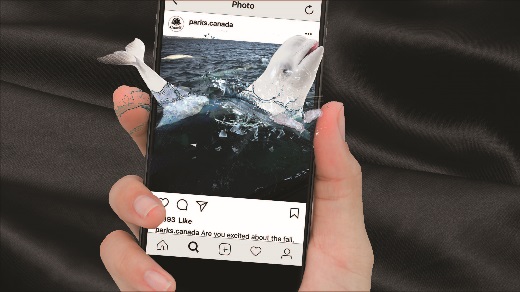

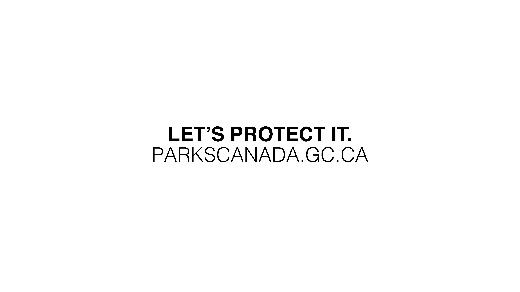
“This is interesting and unique. Everyone is on their device. It makes me smile.” Parent
Despite its creativity, the concept is not clearly associated with Parks Canada and many confused this concept with an advertisement for smartphones or applications that demonstrate the quality of the technology. This further created brand confusion with Parks Canada.
“Quand je regarde les images qu’on me propose, on voit le cellulaire on dirait qu’on me vend une application, un nouveau Android ou n’importe quoi.” (When I see the images, I see the cellular phone and it looks like they are selling an application, a new Android phone or something else.) Millennial
“This is suggesting you can admire it [park] from afar and you don’t need to go.” Parent
The sole focus on the ocean also caused confusion, as many do not associate oceans with National Parks. In addition, the visuals do not uniquely identify Parks Canada, suggesting that it can apply to any ocean areas around the world, or for the promotion of water-related activities.
“C’est plus le genre de publicité pour aller voir les baleines. C’est pas clair que c’est pour Parcs Canada.” (It’s more like an ad for whale-watching. It isn’t clear that this is for Parks Canada.) Parent
“There is a real disconnect between the video and the message and National Parks. It could be any part of the world. This doesn’t suggest anything about Canada.” Newcomer
Because of message and brand confusion, some took exception to the inclusion of a smartphone in the promotion of natural National Parks and though it was inappropriate.
On its own, the advertisement suggested a regional focus that does not speak to Canadians living inland. Even when reminded that the concept would include a variety of ads showing other settings, participants questioned the appropriateness of featuring a setting that is not strongly identified to Canada’s National Parks. It was felt that the technology is given priority over nature in this concept.
“When I think of the National Parks, to me I think more of like the wilderness and trees and mountains and not so much the ocean.” Millennial
“The whole idea of going to a National Park should be to get away from technology.” Parent
As mentioned, there was confusion regarding the intended message and the purpose of the ad. Some believed that the concept suggests you can experience or learn about National Parks online, without visiting, while others believed it encourages Canadians to stop looking at their phone and experience National Parks in person. At the same time, the concept implied that information on where National Parks are located can be found on the Parks Canada website.
“Venez visiter notre site internet pour découvrir où vous désirez aller dans votre prochain voyage. On va vous montrer ce qui est disponible.” (Visit our website to discover where you should go on your next trip. We will show you what is available.) Parents
“The messages is that today everyone is on their phone a lot. It says get out there and go visit the parks and help preserve them.” Millennial
“Tu n’as pas besoin de te déplacer pour voir les Parcs Nationaux, tu peux les voir sur YouTube. C’est plus comme ça que je le perçois. Assis dans ton salon et regarde avec tes appareils électroniques pour voir ce que c’est Parcs Canada.” (You don’t need to go somewhere to see National Parks, you can see them on YouTube. That’s how I see it. Sitting down in your living room looking at what is Parks Canada on your electronic devices.) Parent
To more clearly communicate the message of visiting National Parks, it was suggested that perhaps the female could be drawn into the smartphone to ‘bring the person to the park’ rather than having the park comes to her.
“You need to bring the person to the park. Instead of the whale coming out, she should have been pulled in. This ad is just selling me a cell phone package…” Parent
Regardless, it was believed that the concept does not clearly convey the conservation message. In fact, it was felt the only suggestion of conservation is to protect National Parks by experiencing it online rather than by visiting. Some felt that the imagery does not clearly convey the reasons to focus on conservation of National Parks.
“This is confusing. It says instead of going, just visit electronically.” Parent
“Il manque un élément : jusqu’à la fin on ne sait pas que c’est problématique. Mais la publicité est propre à notre génération.” (There is an element missing. Up to the end, we do not know that [the health of National Parks] is problematic. But the ad is speaking to our generation.) Millennial
After discussing the concept, a few participants believed that the ad implies that National Parks are easily accessible, although care must be taken in using them so as not to disturb their fragile ecosystems.
“C’est près de nous, la nature est près de nous. L’écosystème est fragile et il faut en prendre soin. Prendre soin de nos parcs.” (Nature is close to us. The ecosystem is fragile and we need to take care of it. To take care of our parks.) Parents
Just a few across locations believed that the concept implied that to continue to build good memories of National Parks and have the ability to experience them in the future, we must protect Canada’s natural settings.
“Elle a eu du plaisir, elle a les images dans son téléphone et si tu veux avoir ces plaisirs la prochaine fois il faut les préserver.” (She’s having fun, she sees the images in her phone. If you want to have those pleasures next time, you must protect (nature).) Millennial
“These places are for us to enjoy and by engaging with them we are increasing our awareness and protecting them. These places are within our reach.” Millennial
Millennials and younger Canadian adults were considered to be the primary target audience for this campaign. Indeed, the use of technology featured in the scenario was considered realistic and representative of young adults’ lifestyle.
“J’ai 24 ans et j’utilise mon cellulaire de cette façon-là.” (I’m 24 years old and I use my cellular phone that way.) Millennial
“The young generation needs to know that nature and wilderness is attainable and the phone is a good icon for that.” Millennial
“This is all about young millennials.” Parent
Original Tagline:
The force of the ocean/nature/history. Let’s protect it.
La force de l’océan/la nature/l’histoire. Préservons-la.
The tagline lacked appeal or relevance. The use of the word ‘force’ implies powerful, significant natural forces that are not associated with nature in National Parks. It was suggested that words, such as ‘beauty’ or ‘grandeur’ be used instead of the word ‘force’ to reflect the scenic beauty associated with National Parks.
“Moi aussi je trouve que la force ce n’est pas le mot qu’on associe avec nature mais plutôt la grandeur ou beauté ce serait mieux.” (I also find that the word ‘force’ is not the word we associate with nature, but rather ‘grandeur’ or ‘beauty’ would be better.) Parent
More importantly, a natural force was considered something that cannot be tamed, controlled and does not need protecting. If anything, people need protection from natural forces. For instance, the force of the ocean was deemed to be waves, storms, currents, while the force of nature was most closely associated with events such as hurricanes, tornadoes, and forest fires. The force of nature elicited a sentiment of fear.
“ La force de la nature peut être épeurant; quand il pleut, il pleut et il pleut.” (The force of nature can be scary. When it rains, it rains and rains.) Parent
“We can’t protect the force of nature. People may actually need protection from them! Natural forces doesn’t make sense in this context.” Parent
Moreover, while the concept suggested the importance of protecting nature, it did not suggest how this can be done.
“Ça dit de préserver ce qui est montré mais ça ne donne pas de moyens concrets. Ça ne me dit pas comment je peux préserver la nature.” (It says to preserve what is shown, but it does not give you concrete means of doing so. It does not say how I can protect nature.) Millennial
“In honesty I am confused what they are trying to do… I get the play on words with the force of nature but I do not know how it applies here and how I am supposed to protect it.” Millennial
At times, the tagline was reminiscent of the movie Star Wars, primarily due to the use of the word, ‘force’.
Alternate Tagline:
Discover the power of the ocean/nature/history and the means to preserve it.
La force de l’océan/la nature/l’histoire. Découvrez comment la préserver.
Participants were shown an alternative tagline for their consideration. This version was clearly preferred and deemed more relevant and appropriate. It was viewed as encouraging the viewer to get involved and discover National Parks. That being said, the use of the word ‘power’ speaks to force and consideration should be given to change it to a word that suggests more exploratory components such as ‘beauty’, ‘grandeur’, and ‘wonder’.
“Il m’interpelle plus. Je sens que je peux faire une différence dans le slogan. Ce n’est pas juste le gouvernement. Ça m’invite à faire l’effort pour préserver la nature.” (It is more compelling. I feel like I can make a difference with this slogan. It isn’t just the government. It invites me to make an effort to protect nature.) Parent
“Le ‘découvrez’ m’intéresse. Ça nous dit que si je m’informe, il y a des actions que je peux faire.” (The word, ‘discover’ is of interest to me. It tells us that if I get information, there are actions I can take.) Millennial
“Preserve feels like a kinder word than protect – I could see ‘Discover the force of the ocean and the means to preserve it’.” Millennial
“Discover entices people to get involved. It is welcoming and inviting.” Parent
Alternate Tagline:
Let go of your phone and go live it in real time.
Laissez vos cellulaires et aller le vivre dans la vraie vie.
The second alternate tagline aligned with the concept but did not establish personal relevance to everyone. Some Millennials took offense with the statement sounding more like an order than an invitation to get off their phone. It was also believed that this tagline would simply repeat the message conveyed in the scenario, rather than introduce new elements.
“Propose-le-moi plutôt que de me dire de faire quelque chose. Dis-moi pas d’arrêter d’utiliser le cellulaire.” (Recommend it to me rather than telling me to do it. Don’t tell me to stop using my pone.) Millennial
“That message was already conveyed by the images and I don’t need verbiage to hammer that home.” Millennial
Parents, however, generally appreciated the suggestion that people should take time to remove themselves from technology.
“It’s a good suggestion to unplug, and leave your phone behind. People don’t do it enough.” Parent
When asked what would establish greater personal relevance, or make the concept more effective, suggestions provided by participants included:
Parks Canada – 2017 National Campaign Advertising Concept Pretesting Screener – FINAL
Name:___________________________________________________________________________
Province:__________________________________ City:__________________________________
Tel.(H):__________________________________ Alt Tel.:________________________________
Group
1 2 3 4 5 6 7 8 9
FOCUS GROUPS:
Wednesday, December 6th
| Group 1 | 5:00pm – 6:30pm EST | Parents: Halifax/Fredericton/St. John’s |
| Group 2 | 6:00pm – 7:30pm EST | Parents: Montreal (French) |
| Group 3 | 7:00pm – 8:30pm EST | Parents: Regina/Saskatoon/Winnipeg |
| Group 4 | 8:00pm – 9:30PM EST | Millennials: Mix of locations in Quebec (French) |
| Group 5 | 9:00pm – 10:30pm EST | Parents: Vancouver/Calgary/Edmonton |
Thursday, December 7th
| Group 6 | 6:00pm – 7:30pm EST | Parents: Quebec City (French) |
| Group 7 | 6:30pm – 8:00pm EST | Parents: Toronto/Ottawa |
| Group 8 | 8:00pm – 9:30pm EST | Millennials: Mix of locations |
| Group 9 | 8:30pm – 10:00PM EST | Newcomers: Mix of locations |
Hello, my name is____ and I am with Corporate Research Associates, a public opinion and market research firm. We are conducting a series of small online group discussions on behalf of the Government of Canada to gain feedback on some advertisements. May I speak with someone in your household who is at least 18 years of age and is involved in decisions related to travel?
Please note, this information will remain completely confidential and you are free to opt out at any time. I will take approximately 6–7 minutes. Thank you
Gender (By Observation):Recruit Mix
To begin, are you or anyone in your household currently employed or have ever been employed in any of the following areas?
IF YES TO ANY OF THE ABOVE, THANK AND TERMINATE
Into which of the following age groups do you currently fall? Are you…?
See age/children quotas – mix of ageDo you currently have children under the age of 18 living in the house with you?
See age/children quotasAGE/CHILDREN QUOTAS:
PARENTS GROUPS: 18+ year old WITH children who are less than 18 years old
MILLENNIALS GROUPS: 18–34 years old with NO children
NEW CANADIANS GROUPS: mix of age; with or without children
[IF YES IN Q4] How many people under the age of 18 are there in your household?
[RECORD] _______________
Are you involved in making decisions regarding travel in your household?
Were you born in Canada?
[ASK IF NO IN Q6] How many years have you been living in Canada?
[RECORD # of Years: _________]
Which of the following best describes your interest in national parks, the outdoor and/or cultural settings? Are you [READ RESPONSES]?
In your opinion, how important is the protection of Canada’s nature areas and historic sites? Is it [READ RESPONSES]?
To the best of your knowledge, what is the name of the organization or government department that operates officially designated National Parks and National Historic Sites of Canada? DO NOT READ RESPONSES – CODE ONE ONLY
Have you visited a National or Provincial/State Park or Historic Site within the past 5 years?
Moving on…
What is your current employment status? Are you [READ RESPONSES]? CODE ONE ONLY
If employed, ask… What is your current occupation? ____________________________
TERMINATE IF SIMILAR OCCUPATIONS AS IN Q1
What is the highest level of education you have finished? READ RESPONSES IN ORDER—CODE ONE ONLY
Recruit a good mixWhich of the following best describes your total household income before taxes last year? Would you say…? READ RESPONSES IN ORDER—CODE ONE ONLY
Recruit a good mixThe discussion groups for this project will be conducted over the phone and online and will require the use of a laptop or desktop computer. Do you have access to a computer with high-speed Internet to take part in this focus group?
When was the last time you attended a group discussion or interview? __________
How many groups and interviews have you attended in the past 5 years? __________IF 3 or more Thank & Terminate
What was / were the subject(s) of the group(s)? _______________
IF THEY HAVE BEEN TO A GROUP IN THE PAST 6 MONTHS - THANK & TERMINATE,
IF THEY HAVE BEEN TO 3 OR MORE GROUPS IN THE PAST 5 YEARS - THANK & TERMINATE
IF PARTICIPATED IN A PAST GROUP ON NATIONAL PARKS / TOURISM / ADVERTISING – THANK & TERMINATE
If you won a million dollars what would be the first two things you would do with the money?
(MUST HAVE TWO RESPONSES TO ACCEPT).
TERMINATE IF FLIPPANT, COMBATIVE OR EXHIBITS DIFFICULTY IN RESPONDING
TERMINATE IF RESPONDENT OFFERS ANY REASON SUCH AS SIGHT OR HEARING PROBLEM, A WRITTEN OR VERBAL LANGUAGE PROBLEM, A CONCERN WITH NOT BEING ABLE TO COMMUNICATE EFFECTIVELY OR IF YOU HAVE A CONCERN.
INVITATION – NETFOCUS GROUPS
I would like to invite you to participate in a small group discussion that will be conducted over the telephone and on the Internet at ______ [INSERT TIME] on [INSERT TIME]. This conference call will be used to gather your thoughts and opinions on some advertisements. You would simply log on to a secure website from your computer either from home or work and at the same time join in a group discussion via conference call. The discussion will consist of 6 to 9 people and will be very informal. It will last up to an hour and a half and you will receive $75 in appreciation for your time.
Are you interested in participating?
The discussion in which you will be participating will be audio recorded for research purposes only. Please be assured your comments and responses are strictly confidential. Are you comfortable with the discussion being audio recorded?
There may also be observers who will listen to the discussion, for research purposes only. They will not be given the last names of participants. Are you comfortable with having observers?
Could we please confirm the email address where we can send you the detailed conference call instructions for logging in to the group?
Record email address (and verify): ________________________________________________.
We will send you the instructions at least 1 day in advance of the group. When joining the discussion, please call in 15 minutes before the beginning of the conference call. If you arrive late, we will not be able to include you in the discussion, and will not provide you with the incentive.
As mentioned, we will be pleased to provide everyone who participates with $75, and you can choose to receive your incentive by cheque or through PayPal. Please note it takes approximately 2-3 weeks following your participation to receive an incentive by cheque and 5-7 days to receive an incentive through PayPal. If you do choose to receive your incentive through PayPal you will need to have a PayPal account.
[IF REQUIRED: To learn more about PayPal or to setup a PayPal account you can visit their website at www.paypal.ca].Would you prefer to receive your incentive through PayPal or by cheque?
IF INCENTIVE BY PAYPAL:
A few days after your interview you will receive an email from Corporate Research Associates indicating that your incentive is ready. You will simply need to log in to your PayPal account and the incentive will go into your PayPal balance. Once you’re logged into your account you can click “Withdraw” to view your withdrawal options.
IF INCENTIVE BY CHEQUE:
Could I have the mailing address where you would like the cheque mailed to following your participation?
Mailing address:________________________________________________________________
City: ________________________________________________________________________
Province: ____________________________________Postal Code: _____________________
And please confirm the spelling of your name: _______________________________________
As these are very small groups and with even one person missing, the overall success of the group may be affected, I would ask that once you have decided to attend that you make every effort to do so. If you are unable to take part in the study, please call_____ (collect) at ________as soon as possible so a replacement may be found.
Thank you for your interest in our study. We look forward to hearing your thoughts and opinions!
ATTENTION RECRUITERS
CONFIRMING
Parcs Canada – Questionnaire de prétest sur des concepts publicitaires relatifs à la campagne nationale 2017 – version finale
Nom : ___________________________________________________________________________
Province : __________________________________ Ville : __________________________________
Tél (résidence) : __________________________________ Autre numéro de tél : ________________________________
Groupe
1 2 3 4 5 6 7 8 9
GROUPES DE DISCUSSION :
Mecredi le 6 decembre
| Group 1 | 5:00pm – 6:30pm EST | Parents: Halifax/Fredericton/St. John’s |
| Group 2 | 6:00pm – 7:30pm EST | Parents: Montreal (French) |
| Group 3 | 7:00pm – 8:30pm EST | Parents: Regina/Saskatoon/Winnipeg |
| Group 4 | 8:00pm – 9:30PM EST | Millennials: Mix of locations in Quebec (French) |
| Group 5 | 9:00pm – 10:30pm EST | Parents: Vancouver/Calgary/Edmonton |
Jeudi le 7 decembre
| Group 6 | 6:00pm – 7:30pm EST | Parents: Quebec City (French) |
| Group 7 | 6:30pm – 8:00pm EST | Parents: Toronto/Ottawa |
| Group 8 | 8:00pm – 9:30pm EST | Millennials: Mix of locations |
| Group 9 | 8:30pm – 10:00PM EST | Newcomers: Mix of locations |
Bonjour, je m’appelle ____ et je travaille pour Corporate Research Associates, une société d’étude de marché et de sondage d’opinion publique. Nous effectuons actuellement une série de discussions en petits groupes pour le compte du gouvernement du Canada afin d’obtenir des commentaires sur certaines publicités. Puis-je parler à une personne de votre foyer qui est âgée de 18 ans ou plus et qui participe aux décisions reliées au voyage?
Les renseignements que vous nous fournissez demeureront strictement confidentiels et vous avez la liberté de refuser de participer en tout temps. Je discuterai avec vous pendant environ 6 à 7 minutes. Merci
Sexe (par observation):
Parmi les membres de votre foyer, y compris vous-même, y a-t-il quelqu’un qui travaille ou a déjà travaillé dans un des secteurs suivants?
SI LA RÉPONSE À L’UNE DES OPTIONS CI-DESSUS EST « OUI », REMERCIER LA PERSONNE ET TERMINER L’ENTREVUE
Dans laquelle des catégories d’âge suivantes vous situez-vous actuellement? Avez-vous...
Voir les quotas d’âge et d’enfants – mélange d’âgesAvez-vous actuellement des enfants âgés de moins de 18 ans qui habitent avec vous?
Voir les quotas d’âge et d’enfantsQUOTAS D’ÂGE ET D’ENFANTS :
GROUPES DE PARENTS : participants âgés de 18 ans et plus AVEC des enfants de moins de 18 ans
GROUPES DE LA GÉNÉRATION Y : participants âgés entre 18 et 34 ans SANS enfants
GROUPES DE NOUVEAUX ARRIVANTS AU CANADA : mélange d’âge; avec ou sans enfants
[SI LA RÉPONSE À LA Q4 EST OUI] Combien d’enfants de 18 ans et moins habitent dans votre maison?
[INSCRIRE] _______________
Participez-vous aux décisions reliées aux voyages dans votre foyer?
Êtes-vous né au Canada?
[DEMANDER SI LA RÉPONSE À LA Q6 EST NON] Depuis combien d’années vivez-vous au Canada?
[INSCRIRE le nombre d’années : _______________]
Laquelle des affirmations suivantes décrit le mieux votre intérêt envers les parcs nationaux, les activités de plein air ou les milieux culturels? Êtes-vous [LIRE LES RÉPONSES]
Selon vous, à quel point la protection des aires naturelles et sites historiques du Canada est-elle importante? Est-ce que c’est [LIRE LES RÉPONSES]?
À votre connaissance, quel est le nom de l’organisme ou du ministère gouvernemental qui gère officiellement les parcs nationaux et les lieux historiques nationaux du Canada désignés? NE PAS LIRE LES RÉPONSES – CODER UNE SEULE RÉPONSE
Avez-vous visité un parc national, un parc provincial ou un parc d’État ou un lieu historique dans les 5 dernières années?
Passons à l’autre question…
Quelle est votre situation professionnelle actuelle? Êtes-vous [LIRE LES RÉPONSES]? CODER UNE SEULE RÉPONSE
Recruter un mélange de situations d’emploiSi le répondant est un employé, demander… Quelle est votre profession actuelle? ____________________________
TERMINER L’ENTREVUE SI LA PROFESSION EST SEMBLABLE À CELLES DE LA Q1
Quelle est votre situation professionnelle actuelle? Êtes-vous LIRE LES RÉPONSES DANS L’ORDRE – CODER UNE SEULE RÉPONSE
Recruter une bonne combinaisons des différents niveaux de scolaritéLaquelle des catégories suivantes décrit le mieux le revenu total avant impôts de votre foyer pour l’an dernier? Serait-ce... LIRE LES RÉPONSES DANS L’ORDRE – CODER UNE SEULE RÉPONSE
Recruter une bonne combinaison des différentes catégories de revenusChaque discussion en groupe dans le cadre de ce projet se fera par téléphone et en ligne et nécessitera l’utilisation d’un ordinateur de bureau ou d’un ordinateur portable. Avez-vous accès à un ordinateur doté d’une connexion Internet haute vitesse pour prendre part à la discussion?
Dans quelle mesure êtes-vous à l’aise d’utiliser un ordinateur, sans aide? Êtes-vous…
Lorsque vous serez en ligne pour participer au groupe, vous devrez également participer à une conférence téléphonique pour prendre part à la discussion. Aurez-vous accès à un téléphone séparé de votre ordinateur pour participer à la discussion?
Avez-vous déjà participé à une discussion de groupe ou à une entrevue pour laquelle vous avez été rémunéré?
À quand remonte votre dernière participation à un groupe de discussion ou à une entrevue? __________
À combien de groupes et entrevues avez-vous participé au cours des cinq dernières années? SI trois ou plus, remercier et terminer l’entrevue
Quels étaient les sujets du ou des groupes? _______________
SI LA PERSONNE A PARTICIPÉ À UN GROUPE DE DISCUSSION AU COURS DES SIX DERNIERS MOIS, LA REMERCIER ET TERMINER L’ENTREVUE.
SI LA PERSONNE A PARTICIPÉ À TROIS GROUPES DE DISCUSSION OU PLUS AU COURS DES CINQ DERNIÈRES ANNÉES, LA REMERCIER ET TERMINER L’ENTREVUE.
SI LA PERSONNE A DÉJÀ PARTICIPÉ À DES GROUPES DE DISCUSSIONS AU SUJET DES PARCS NATIONAUX, DU TOURISME ET DE LA PUBLICITÉ, LA REMERCIER ET TERMINER L’ENTREVUE.
Si vous gagniez un million de dollars, quelles seraient les deux premières choses que vous feriez avec l’argent?
(DOIT AVOIR DEUX RÉPONSES POUR ACCEPTER.)
L’ENTREVUE SI LA PERSONNE RÉPOND D’UNE FAÇON DÉSINVOLTE OU COMBATIVE OU PRÉSENTE TERMINER DES DIFFICULTÉS À RÉPONDRE. TERMINER L’ENTREVUE SI LA PERSONNE QUI RÉPOND FAIT PART D’UNE RAISON TELLE QU’UN PROBLÈME D’OUÏE, DE VUE OU DE LANGAGE ÉCRIT OU VERBAL, D’UNE CRAINTE DE NE POUVOIR ÊTRE CAPABLE DE COMMUNIQUER EFFICACEMENT, OU SI VOUS-MÊME AVEZ UNE PRÉOCCUPATION.
INVITATION – GROUPES NETFOCUS
J’aimerais vous inviter à participer à une petite discussion de groupe qui sera tenue par téléphone et par Internet à ______ [INSÉRER L’HEURE] le [INSÉRER LA DATE]. Nous utiliserons cette conférence téléphonique pour connaître ce que vous pensez de quelques publicités. Vous n’aurez qu’à ouvrir une session sur un site Web sécurisé depuis votre ordinateur, soit chez vous, soit au travail, et à vous joindre à la discussion dans une conférence téléphonique en même temps. De six à neuf personnes participeront à la discussion, qui sera très informelle. La discussion durera une heure et demie et vous recevrez 75 $ en guise de remerciement.
Souhaitez-vous participer à la discussion?
La discussion à laquelle vous prendrez part sera enregistrée uniquement pour des fins de recherche. Soyez assuré que vos commentaires et réponses demeureront strictement confidentiels. Êtes-vous à l’aise avec le fait que la discussion soit enregistrée?
Certains observateurs pourraient également écouter la discussion pour des fins de recherche. Ils n’auront cependant pas accès au nom de famille des participants. Êtes-vous à l’aise avec la présence d’observateurs?
Pourriez-vous également nous confirmer votre adresse électronique afin que nous puissions vous envoyer des instructions précises sur la façon de participer à la conférence téléphonique de votre groupe?
Noter l’adresse électronique (et la vérifier) : ________________________________________________.
Nous vous enverrons les instructions au moins un jour avant la discussion. Nous vous prions de composer le numéro 15 minutes avant le début de la conférence téléphonique. Si vous êtes en retard, nous ne pourrons ni vous inclure dans la discussion ni vous verser la récompense.
Comme nous vous l’avons mentionné, nous aurons le plaisir de remettre à tous les participants 75 $, que vous pourrez avoir soit par chèque, soit par PayPal. Veuillez noter que vous devrez attendre de deux à trois semaines après avoir participé à la discussion pour recevoir un chèque et de cinq à sept jours pour recevoir le paiement par PayPal. Si vous optez pour le paiement par PayPal, vous devrez avoir un compte PayPal.
[AU BESOIN : Pour en apprendre davantage au sujet de PayPal ou pour vous créer un compte, consultez le site Web www.paypal.ca].Voudrez-vous recevoir cette somme par PayPal ou par chèque?
SI LE RÉPONDANT CHOISIT PAYPAL :
Quelques jours après votre entrevue, vous recevrez un courriel de la part de Corporate Research Associates vous avisant que votre récompense en argent est prête. Vous n’aurez qu’à ouvrir votre compte PayPal afin que l’argent soit crédité à votre solde. Une fois dans votre compte, vous pourrez cliquer sur « Virer de l’argent » pour voir comment vous pouvez retirer votre argent.
SI LE RÉPONDANT CHOISIT CHÈQUE :
Pourrais-je avoir l’adresse postale où vous aimeriez que ce chèque soit envoyé après votre participation?
Adresse postale : ______________________________________________________________
Ville : ________________________________________________________________________
Province : ____________________________________ Code postal : _____________________
Veuillez également confirmer comment épeler votre nom : ______________________________________
Puisqu’il s’agit de très petits groupes, le succès pourrait être compromis si une des personnes invitées manquait à l’appel. C’est pourquoi je vous demande, si vous avez décidé de participer, de faire tout votre possible pour y assister. Si vous êtes dans l’impossibilité d’être présent à la discussion, veuillez communiquer avec _____ (appel à frais virés) au ________ le plus tôt possible afin que nous puissions trouver une autre personne pour vous remplacer.
Nous vous remercions de l’intérêt que vous témoignez à notre étude. Nous avons hâte de connaître vos pensées et vos opinions!
AVIS AUX RECRUTEURS
CONFIRMATION
Study Goals (Confidential – Not read to participants)
As you may or may not know, Parks Canada is responsible for protecting and preserving Canada’s national parks, as well as its national historic sites.
Today I’d like to get your thoughts on three ideas for an advertising campaign being considered for national parks in Canada that speak of conservation. For the purpose of today’s testing, each campaign includes one 30-second video that could be seen on television, in cinemas, or online. When the campaign is finalized, there could be additional videos, or perhaps other types of advertisements. With this in mind, I will ask you to focus on the concept or idea behind the video and the message being communicated, understanding that these could be used to develop other parts of this campaign.
Keep in mind that what I am showing you today is currently in development. Instead of showing you a video, I will show you a series of images with explanations, to give you an idea of what the video would look like once it is produced. So you will need to imagine what the video would look like as I am describing it to you. Let’s have a look at the first concept; hold your thoughts as I am showing it to you as you will complete an individual exercise before we discuss this campaign together. Moderator presents one concept at a time - Rotate order of concept across groups – For the Time Lapsed concept, show example: I would like to show you an example of what the time lapsed effect would look like. For the Time Lapsed concept, show version that is aligned to the target audience: Millennials guide and Parents/Newcomers (Family guide).
[POLLS 1-15] Before we chat about this concept, I’d like you to complete a few individual exercises:
I will give you a moment to complete these exercises before talking about it together. Moderator opens the polls on the screen
Group discussion, following the exercise:
[POLLS 16-19] Now that we have seen three different campaigns, I would like to know which one works best at achieving certain things. Take a moment to indicate which is most likely to achieve the following, and explain why you chose this concept.
I will give you a moment to do so. Moderator opens the polls on the screen
Group discussion, following the exercise:
That’s all my questions. On behalf of Parks Canada, thank you for taking part in our discussion. You’ll be receiving your incentive within the next two weeks.
Objectifs de l’étude (confidentiel : ne pas lire aux participants)
Comme vous le savez peut-être, Parcs Canada est responsable de la protection et de la conservation des parcs nationaux ainsi que des lieux historiques nationaux au pays.
Aujourd’hui, j’aimerais connaître votre opinion sur trois idées d’une campagne publicitaire à l’étude pour les parcs nationaux du Canada qui se penchent sur la conservation. Aux fins des tests d’aujourd’hui, chaque campagne comprend une vidéo de 30 secondes qui peut être visionnée à la télévision, dans les cinémas, ou en ligne. Quand la campagne sera terminée, d’autres vidéos ou d’autres types de publicités pourront être ajoutés. Pour cette raison, je vais vous demander de vous concentrer sur le concept ou l’idée dans la vidéo et le message qui est transmis, tout en comprenant qu’ils pourraient être utilisés dans d’autres composantes de la campagne.
Gardez en mémoire que ce que je vous montre actuellement est en cours d’élaboration. Au lieu de vous montrer la vidéo, je vais vous présenter une série d’images avec des explications qui indiquent de quoi aura l’air la vidéo une fois que la réalisation sera terminée. Je vais vous demander d’utiliser votre imagination pour vous faire une idée de ce dont aura l’air la version finale de la vidéo pendant que je vous en fais la description. Jetons un œil sur le premier concept. J’aimerais que vous reteniez vos commentaires pendant que je vous le montrerai, car vous devrez d’abord terminer un exercice individuel avant de discuter de la campagne ensemble. L’animateur présente un concept à la fois. Alterner l’ordre de présentation des concepts d’un groupe à l’autre. Pour le concept du Temps écoulé, montrez un exemple : j’aimerais vous montrer un exemple de ce qu’aurait l’air le concept du temps écoulé. Pour le concept du Temps écoulé, montrez la version qui correspond au public cible : guide de la génération Y et les parents/nouveaux arrivants (guide de la famille).
[QUESTIONS 1 À 12] Avant de parler du concept, j’aimerais que vous terminiez quelques exercices individuels :
Je vais vous laisser quelques minutes pour terminer ces exercices avant d’en discuter ensemble. L’animateur procède au sondage sur l’écran.
Discussion en groupe après l’exercice :
Passons maintenant à une autre idée. L’animateur présente un deuxième et un troisième concept et répète les exercices et la discussion.
[QUESTIONS 13 À 15]Maintenant que nous avons vu les trois différentes campagnes, j’aimerais savoir laquelle atteint le mieux certains objectifs. Prenez le temps d’indiquer laquelle est la plus susceptible d’atteindre les objectifs suivants, et expliquer pourquoi vous avez choisi ce concept.
5) Ce concept illustre mieux l’importance de conserver les parcs naturels nationaux du Canada.
6) Ce concept m’incite plus à visiter un parc national.
7) Ce concept est le plus susceptible de suggérer que la visite des parcs nationaux créera des souvenirs durables.
8) Ce concept est celui qui me rend le plus fier des parcs nationaux du Canada.
Je vais vous donner quelques instants pour écrire vos réponses. L’animateur procède au sondage sur l’écran.
Discussion en groupe après l’exercice :
Et voilà, je n’ai plus de questions pour vous. Au nom de Parcs Canada, je vous remercie d’avoir participé à la discussion. Vous recevrez votre récompense au cours des deux prochaines semaines.
